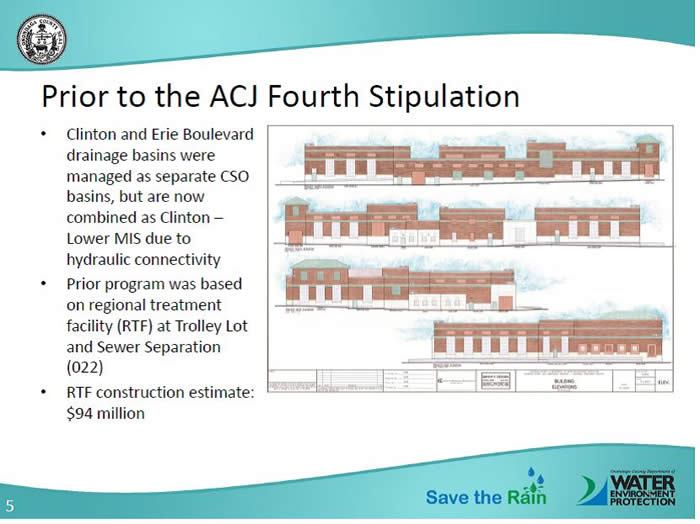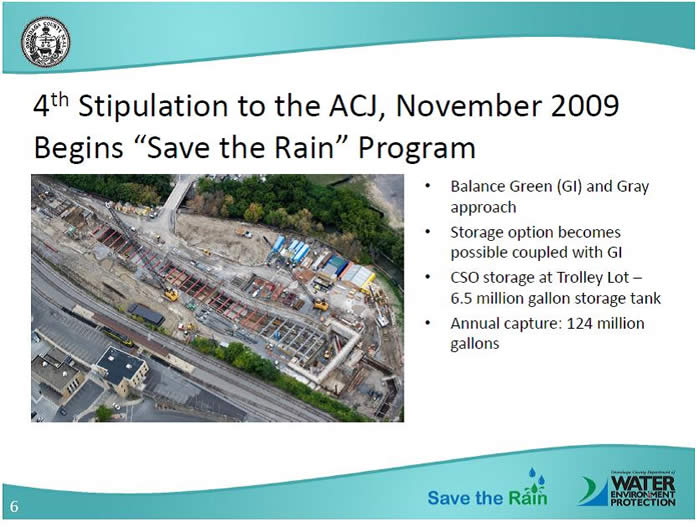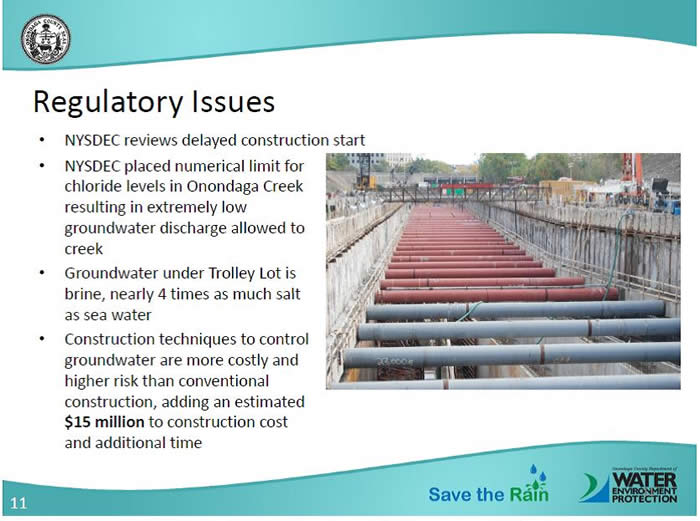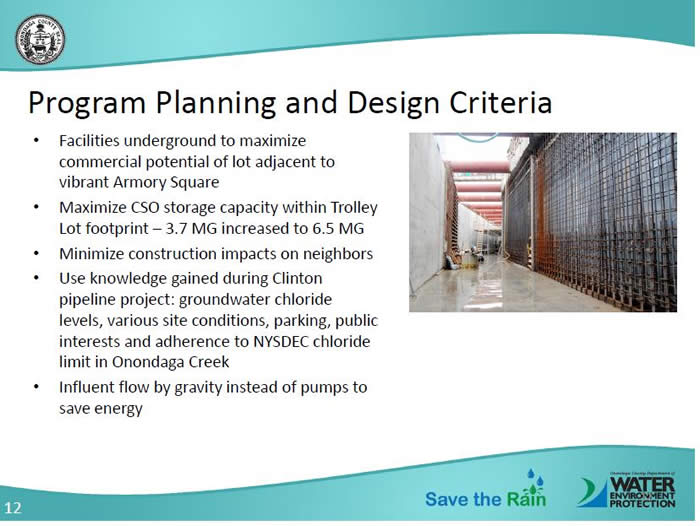ENVIRONMENTAL PROTECTION COMMITTEE MINUTES - DECEMBER 11, 2013
MICHAEL E. PLOCHOCKI, CHAIRMAN
MEMBERS PRESENT: Mr. Shepard, Mrs. Tassone, 1Mrs. Rapp
MEMBERS ABSENT: Ms. Williams
ALSO ATTENDING: Mr. Dougherty and see attached list
Chairman Plochocki called the meeting to order at 9:07 AM. A motion was made by Mrs. Tassone, seconded by Mr. Shepard to waive the reading of the minutes of the proceedings of the previous committee meeting. Passed unanimously; MOTION CARRIED. A motion was made by Mrs. Tassone, seconded by Mr. Shepard to approve the minutes of the proceedings of the previous committee. Passed unanimously; MOTION CARRIED.
1Mrs. Rapp arrived at the meeting.
1. WATER ENVIRONMENT PROTECTION: Tom Rhoads, Commissioner; Robert Kukenberger, Vice President CDM Smith
a. A Resolution Approving the Costs of Certain Improvements for CSO Improvements for the Onondaga County Sanitary District
Chair Plochocki:
-
Reconciliation of Clinton CSO project reviewed last month; financially ahead of the game, if County Executive had continued with original plan for RTFs the increase would have been an additional $15M minimum
-
$20M increase over original budget
-
Detailed information provided last month – had time to digest, now able to dig deeper; public hearing was approved
Mr. Rhoads provided a presentation handout to the committee (on file with the Clerk) and presented the following highlights:
- 3 main points
- Could have cost $94M as originally planned with RTFs (slide 3)
- Strong awareness of budget at $61.5M and estimate at $79M (slide 13)
- Why award project with estimated cost higher than budget of $61.5M (slide 16)
 
- Old program would tear down neighborhoods, building huge aboveground RTFs using swirl concentrator technologies; swirls, disinfects after removing some of the solids and releases into the creek
- County Executive proposed change; original project slated for $94M, could have cost more
- RTFs without storage on the frontend have had water quality issues in other areas; could have spent a lot of money and not gotten a satisfactory result
- Important to understand this before moving to slide 13
- Referenced minutes from website of the June 15, 2011 EP committee showing estimated construction costs of $79M, prior to opening bids (on file with Clerk)
- Demonstrates there was knowledge of a $61.5M budget and $79M project
- Understands many members of the legislature have changed since 2011

- Reasons to move forward - $31M in grants and ACJ deadline of 12-31-13
- Had to get project started, where aware it was above budget
- Expected reconciliation at the end of the project
- Mindful of being good stewards of public dollars; didn’t want to lose grants or miss ACJ deadline
Mr. Kukenberger:
-
Presentation same as last month other than date change on cover, addition of slide 16 and renumbering of slides following 16
-
Feels confident every decision made on the project was correct; made with much thought, discussion and engineering background
-
Would not have met ACJ deadline if bids were rejected; working round the clock to meet deadline
-
No indication costs would have decreased with rebidding; probably would have increased
-
If rejected and redesigned, would have delay and cost of redesign, still no guarantee it would be less
-
Low bidder proposed alternate method of tunneling verses open cut for the entire facility; reviewed with County Executive and WEP, found to be a better method for construction and meeting deadline
Chair Plochocki asked to break the reconciliation into three parts; $10 million overbid, $10 million construction cost overruns and potential $10 million that the county is being sued over. He believes it is well understood that the bid came in $10 million higher than expected and the reasons for awarding the bid. Similarly understands and appreciates the stand taken with the $10 million that we are being sued over; doesn’t feel costs are appropriate and are glad they were denied. The real question stems from the construction overrun issues, questions why the legislature wasn’t told sooner. Mr. Rhoads responded that the construction estimate was $79 million in 2011, as presented in the minutes. In addition, quarterly reports have a budget section containing the Clinton budget. Each time there was a change in the contract there were remarks in the reports; could see we were above the bid price, all approved change orders are documented in those reports. Chair Plochocki stated that it would be fair to say the legislature was given a $79 million dollar figure and the $77,680,000 figure isn’t news. The news was in 2011, even though the legislature did not actually approve the money at that time. Mr. Rhoads stated his understanding was that there was a need to go full speed ahead to make sure that ACJ deadlines were meet and didn’t lose the grant funds. There were real good reasons to proceed accordingly.
In answer to Mrs. Rapp, Mr. Rhoads responded that $77,680,000 does not include the amount we are being sued for. This is the reason it was included in the slide; want a good transparent discussion. Mrs. Rapp asked if we would discuss that. Mr. Rhoads responded, if and when, it is a long day away. Mrs. Rapp stated that she wants to know more about this.
Chair Plochocki stated that more than 50% of the legislature has changed since 2011; you are saying the legislature was fully briefed. After the bids, there was knowledge that the bids came in $10 million more; he questions why the construction cost weren’t included. Mr. Millea responded:
-
Didn’t come back and ask for $9 million increase from allocated amount as legislature approved $120 million for the Save the Rain program in 2011 – wasn’t called Save the Rain at that time; was in addition to authorization that already existed for the RTF strategy; no need to come back for the additional funds because the program had been funded; unique project component of a larger program, were able to encumber funding in advance of the project
-
Had full knowledge we would need to come back to discuss actual costs; didn’t want to do this several times - management team decided to comeback when close to completion to true up entire budget
-
At no time were we spending monies we didn’t have, were dipping into funds set aside for other proponents of the Save the Rain program; set up budget in 2011 through 2018; promised we wouldn’t come back unless the two significant gray projects came in over projected cost
-
Still tightly managing other components of the Save the Rain project
-
Unforeseen conditions have led to changes throughout the system for large subsurface infrastructure projects; Wetzel Road and Midland CSO 044 had changes
- Important to put the pieces together, what happened and when, and what was communicated and when
Mrs. Rapp asked what would happen if the additional monies aren’t approved. Mr. Millea responded that it would have an extremely detrimental effect on the other components of the Save the Rain program. Mrs. Rapp asked if we would meet the ACJ requirements. Mr. Millea responded that it would absolutely make it very difficult. In answer to Mrs. Rapp, Mr. Millea stated he would not suggest that this is an option.
Mr. Millea stated that we are not here to discuss any scope change or additional funding for the Save the Rain program. We are talking specifically about the project. Had we known then what we know now, we would have added the $20 million in January of 2011. During that period, he had only been on the job for about six months and there was a transition of commissioners; we were working with the best information we had. Mrs. Rapp responded that she remembered the whole conversation; we were on notice that original bids were incorrect and would wait until the end to reconcile, rather than coming in a number of times. However, it is imperative for us to ask these questions, for the what if’s.
Mr. Millea stated that we knew there was a $9 million dollar change from the offset, but we didn’t’ know we would see additional costs come along through the construction phase. He asked that we discuss the significant acceleration costs and the decisions made on those critical points.
In answer to Mrs. Tassone, Mr. Millea stated that all funding approved for Save the Rain projects was driven toward compliance with the consent program, except those approved for the suburban program, which are outside the scope and an additional budget. Anything labeled Save the Rain is consent driven. Chairman Plochocki noted that those additional monies are also for consent judgment as required. Mr. Millea agreed.
Mr. Rhoads referenced slide 14 for the changes made during construction.

In answer to Chair Plochocki, Mr. Kukenberger responded:
-
Construction cost changes were anticipated in the $79 million figure; know below grade risks of a project such as this
-
Overriding feature was the high chloride ground water – 4 times as much salt as sea water; 2003-2005 NYSDEC allowed higher chloride levels to be discharged into the creek
-
In 2007-2008 issues aroused with NYSDEC and environmental groups about potential impact of chlorides on the creek; regulations placed strict guidelines on amount of chlorides discharged to Onondaga Creek; fisheries people maintain we could have discharged chlorides
-
Facility designed to minimize the amount of chloride discharged; resulted in jet grouting and other components that increased costs and risks; also related to claim as this is why grouting was needed
Mr. Kukenberger supplied the following handout detailing the changes listed on slide 14.
- Encountered rocks/boulders below grade
- Present where not expected, very deep
- Caused 90 day delay and extra cost for major pipeline installation by trenchless methods
- Total added cost for rocks/boulders - $939,970
- Major factor in need for acceleration due to the 90 day time delay
- Repair/replacement of existing infrastructure
- Conduit and electrical duct bank repairs
- Existing conveyance repairs
- Caisson repairs
- Sanitary sewer replacement
- Total added cost for repair/replacement of existing utilities : $402,000
- Modifications to improve O&M efficiency
- LED parking lot lighting
- Troweled finish of walls
- Retaining wall modifications
- Facility interior modifications
- Total added cost for enhancements to improve O&M: $504,000
- Acceleration costs
- Overtime
- Six and seven work days per week
- Additional supervision
- Additional equipment
- Total added cost of acceleration: $2,926,564
- Potential Outfall and Creek Modifications
- Engineer and CM will monitor Storage Tank Discharge and Creek Bank for erosion or instability
- If issues, will recommend modifications to strengthen creek bank/bottom
- Budget – Conceptual $200,000
- Contingency
- Allowed 1% contingency for remainder of contract work
Chair Plochocki asked if it was fair to say that as of June 2011, many if not all of the changes during construction were known, which is why the estimate was put in. Mr. Kukenberger responded that the details weren’t known. We were aware of the risks of deep excavation and control of ground water. Mr. Rhoads added that these are subsurface projects. We are dealing with the unknown. There are complex geologies; found old railroad foundations, old excavating material; all sorts of large items. The $79 million estimate was put forth to help the group understand that there were going to be unknown conditions. This is a real world situation and it happens everywhere.
Chairman Plochocki stated this entire discussion comes down to two words, foreseeability and conveyance; what was foreseen when and when was that conveyed to the legislature. What he is hearing is that exact specifics weren’t foreseen, but in June 2011, the potential for problems in this area was conveyed. Today, we are actually a little below the estimate of $79 million, with $77 million and change. Mr. Rhoads responded that he understands the fiduciary responsibility, and the need to ask good questions so that they have confidence in the team. We believe that we have made the right decisions.
In answer to Mrs. Rapp, Mr. Rhoads and Mr. Kukenberger confirmed that there was almost $3 million in acceleration charges. Mrs. Rapp asked what the fine would be if we missed the deadline. Mr. Kukenberger:
-
2 ways to look at acceleration cost; item numbers 1 and 4 are connected
-
Delay caused by rocks/boulders below grade, separate item not related to $10M claim
-
Section of pipeline needed to be installed by tunneling to connect conveyances built in 2007-2008 to this facility; work subcontracted to local company; based on geotechnical baseline report, boring and site history anticipated technique to jack and bore pipe, 3 feet diameter pipe with 4 feet diameter casing; boulders/rocks were expected at a different level, geology in this area dove the boulders down into the pipeline area, weren’t able to proceed with work; work was in critical path of everything following it; had 22 days allowed, took about 120 days to do the work; even with change order of $939,970, company is still at risk of bankruptcy because of the time spent; did everything they possibly could, worked around the clock, manufactured unique boring items to make this happen; was successful – pipeline is in, doesn’t leak and is high quality work
-
Due to pipeline delay the contractor asked for acceleration or extension of time till April; great deal of time spent on analyzing and negotiating with them; original cost for acceleration $3.1M, able to negotiate down to $2.9M – some items are time and material, may come in a little less; time extension cost was $2.8M not including penalties and fines of $5k per day; savings wasn’t big enough to go to time extension, also other issues with time extension; e.g., how all the contractors would work together to get this done; extended PLA to avoid Wicks Law for project, allowing for 1 prime contractor, all others subcontractors; 1 contractor to negotiate acceleration with, they spent 2 months negotiating with their subcontractors and providing an agreement to meet the deadline
Mrs. Rapp asked if we were meeting the deadline. Mr. Rhoads responded that we are going right down to the wire, but are on a path to success. We toured on Tuesday and the construction managers are optimistic, but we are under huge deadline pressure. When we evaluated time related overhead verses acceleration and our exposure to the penalties, this was deep in our discussions. Mrs. Rapp stated that was such a complex issue to get past. Mr. Rhoads added that there is a federal court order and other parties besides the DEC. There are other parties to these lawsuits; we do not have our own destiny in our control. The decision was made to proceed with acceleration. Mr. Kukenberger added that it was a well thought out decision.
In answer to Chair Plochocki, Mr. Rhoads stated that with the fines the cost of extending the contract would have been even greater than the acceleration costs. Mrs. Rapp added that it sounds like it could have been a lot more. Chairman Plochocki stated that we are paying less and not violating the consent order by choosing acceleration. Mr. Rhoads added time related overhead and acceleration were about the same costs, but we would have exposed ourselves to significant penalties, a loss of momentum, and the county would have been seen as a failure, unable to meet its deadlines. There were discussions and risks in each part of this. Mr. Kukenberger added that extending the contract would put more money in the pocket of the engineers. There would have been additional costs for engineering with extension. When you add everything up, this may have been the cheaper option.
Mrs. Rapp asked about the funding sources, questioning if the $300,000 was cash. Mr. Kukenberger and Mr. Rhoads responded:
- Not cash, $300k is an estimate to make the numbers round out
- Agency will deem certain items ineligible; miscellaneous costs - $300k is meant to cover this
- Portion of $300k is revenue received from trolley lot parking
- If unable to include in EFC bond, might be AAA bond
Mrs. Rapp stated that she did not have any information on the lawsuit. Chair Plochocki responded that due today’s tight agenda, he would prefer not to go into executive session. It is not an urgent matter today; just want to notify us of the lawsuit. If there is interest amongst committee members, we could discuss this next month; really want to focus on these costs at hand.
Mrs. Rapp asked if there was an opportunity to decrease the $79 million amount by shuffling around the Save the Rain funds. Mr. Millea:
- No - can go through entire budget and where it is going at the next meeting; 2011 budget presented best effort to get to 2018
-
Within 2018 requirements have ambient monitoring program, green infrastructure program, swim modeling, benchmarks need to be achieved annually and reported each year till 2018; WEP working hard on system optimization, making sure we stay within cost framework already allocated
-
Have had this discussion internally to see where there was flow; working as hard as possible with DEC to avoid incremental capital costs for floatable control facilities, will help save more than $15m
-
Would like funding to be approved after discussion; hope discussion doesn’t lead to what can we cut out of the rest of the program, rest of the program is as important as this project; this project shouldn’t be funded at the expense of structured elements of the Save the Rain program
- Moving forward to keep us on schedule with 2018 obligations
Mrs. Rapp stated that as we continue to receive these awards there may be grant money and help from other sources for our Save the Rain program. Mr. Millea:
-
Grants are few and far between, pursue every grant they can; received $3M for the Civic Strip
-
Pursuing funding from the Water Quality Improvement program for other components of the sanitary system; could benefit from limited grant funding program
-
Have been to Washington to discuss funding at the federal level, not having tremendous success
-
Water Resources Development Act has $0 earmarked for the first time in decades; Congressman Walsh was a master at plugging in significant funding directed towards Onondaga Lake cleanup issues; doesn’t exist any longer
-
Can work through EFC for low interest financing, saves upwards of $8M in interest costs; 2% at 30 years is free money when you do the math on time, value and money
Mrs. Rapp added that Save the Rain pays us back essentially $15 million in O&M costs, by using low tech. Mr. Millea responded that the O&M costs will be far less than what the sewage treatment plant would have cost. Mrs. Rapp stated this needs to part of the record. Mr. Millea added that the life cycle is very important, and the environmental impact is significant. This is a better environmental outcome. Mrs. Rapp added because it is storage as opposed to swirling.
Mrs. Tassone stated that she hopes this is not going to be a trend; bid projects out and partway through the project, we need more money. This is not the way government should be run. We bid a project out and it should be stuck at that bid period. Mr. Millea responded that they agree and are sending that message to our engineering consultant community, as well as the general contractor community. We are going to hold the line on design, construction and potentially pursuing bonding of overages. Onondaga County has never pursued construction bonds.
In answer to Mrs. Rapp, Mr. Millea responded that construction contractors post a bond to insure compliance of the contract. We require these bonds, but have never gone after one when we feel a contractor has failed to perform.
Mr. Millea:
-
Not suggesting the contractor failed to perform in this case, we worked in concert with the contractor to advance this project; no bond issue with this contract
-
Historically have had issues where we might have been able to hold a contractor more liable
-
Now having internal discussions on this; would be a policy shift for us and speaks to Mrs. Tassone’s point
-
Need to talk to the governor about design build; Governor Cuomo authorized design build for state agencies, didn’t include county government
- Design builds projects are at the contractors risk, unforeseen conditions become their liability; fixed price contract
Mr. Kukenberger added that his firm is doing design builds in other parts of the country. Mr. Millea added that we are doing this with the Metropolitan Water Board; looking forward to seeing how this works. This is only done through a performance contract. We would love to do design build for future projects with WEP, as it is not always clear who is at fault; taxpayers are held responsible. Together we need to continue to support our department heads, hold our general contractors and design firms accountable for their performance. A memorializing resolution to the governor suggesting he expand design build to local government would also be extremely helpful.
Chairman Plochocki stated when you have a two-year lag between the times of the refined estimates and approval a perception can arise, in the mind of the public, that there were costs that weren’t unforeseen, resulting in overtime costs and other such things. We need to make sure that the public understands that we are managing their money to the absolute best extent possible. While he isn’t saying anything was wrong in this situation, he can’t emphasis enough the importance of continuing all due diligence and giving us the best estimates early on. Just the perception that something has gone over budget can be difficult.
Mr. Dougherty stated that he agrees completely that we need to do a better job of maintaining the cost. However, he wants to be careful that we don’t pass all the risk onto the contractors. His fulltime job is with a government contractor and there are always unforeseen circumstances that arise. As soon as you pass all the risk onto them, they will raise their prices. Instead of having cost overruns on one or two projects, because of unforeseen problems, we will have higher costs on all of the projects. Contractors aren’t stupid and won’t adopt the chance of all these unforeseen possibilities. On the surface, this may seem to be a great thing, but we will be paying for this across the board. Mr. Millea responded that they are struggling to find a balance. Mr. Dougherty raised a valid point and even in the design build environment, change orders would be permissible in the event that an unforeseen condition is a valid and reasonable adjustment to the design. Chloride is a great example; wouldn’t hold a contractor responsible for regulatory compliance, which was something that they couldn’t have foreseen. Wetzel Road provides an example of what we want to deal with in the design build scenario; have engineer estimate on construction costs, low bid comes in 30%-40% below the estimate, by law, we must award that contractor and then end up in a situation where we have a change order battle throughout the entire project. We have seen this several times.
Mrs. Rapp asked if that happened with this project. Mr. Millea responded that this is the exact opposite. Our engineer’s estimates were $61 million for the tunneling scenario. The tunneling bids came in at $90 million, as the general contractors saw the tunneling risks involved. Jett Industries proposed the cut and cover. Mrs. Rapp asked if they were, the only cut and cover bid. Mr. Millea responded that there were five bids; two were cut and cover. Mr. Kukenberger added that we believe there were three. We don’t know what the others were proposing; hear in the industry that three contractors would have proposed the cut and cover.
In answer to Mrs. Rapp, Mr. Millea confirmed that Jett Industries was the low bid. Mr. Kukenberger added that the low bid, as designed with the tunnels, was $85 million; tunneling bids ranged from $85 - $99 million. Mr. Millea added that this shows Mr. Dougherty’s point, they were hedging their risks and put a premium price on the approach; added additional funds for the risk. Jett mitigated the risks by going to a cut and cover scenario.
Chair Plochocki stated that in a parallel universe if we had decided go with the RTF as planned; there is no reason to believe that these overage costs would have been any different. Mr. Kukenberger agreed. The bids that were taken for the RTF, at the same location, did not have everything built into the design to handle the ground water, as we now know we would have had to do. It is our professional opinion that if we had awarded and gone ahead with the RTF low bid, we would have been facing extreme change conditions to deal with the soils in the ground water. It was going to a similar depth, with very different means to get there. Moreover, that project could have gotten to the point where the contractor could have stopped work, stating they weren’t allowed to discharge ground water to the creek or the Metro Treatment Plant, tell them what to do. Knowing what we know now, we anticipate that this would have happened. In the end, the RTF would have been more risk than the storage facility, because the storage facility was at least designed with that in mind. Just before the June timeframe, as program manager, we had our expert geotechnical people come in and look at the design and their comments were that this was going to be much more expensive.
A motion was made by Chair Plochocki, seconded by Mrs. Rapp to approve this item. Ayes: 3 (Plochocki, Rapp, Shepard); Abstaining: 1 (Tassone). MOTION CARRIED.
b. A Resolution Authorizing the Issuance of $20,000,000 Bonds of the County of Onondaga, New York, to Pay the Cost of CSO Improvements in and for the Onondaga County Sanitary District, Intended to Enable the County to Comply with Requirements Set Forth in the Amended Consent Judgment and Related Municipal Compliance Plan for the Clinton Street Conveyances and Regional Treatment Facility Project, in and for Said County ($20,000,000)
A motion was made by Chair Plochocki, seconded by Mrs. Rapp to approve this item. Ayes: 3 (Plochocki, Rapp, Shepard); Abstaining: 1 (Tassone). MOTION CARRIED.
c. Reducing Authorized Costs for Certain Improvements Made for the Midland Wastewater Treatment Plant in and for the County of Onondaga, New York Pursuant to Section 41.00 of the Local Finance Law, and Amending Resolution Nos. 50-2008 and 51-2008 ($9,756,000)
Mrs. Rapp stated that we could say that the Clinton cost is only $10 million because of the reduction in these Midland funds. Mr. Millea agreed.
A motion was made by Mrs. Rapp, seconded by Mrs. Tassone to approve this item. Passed unanimously; MOTION CARRIED.
d. Memorializing the New York State DEC to Increase the Treatment Capacity Rating at the Oak Orchard Wastewater Treatment Plant
Mr. Dougherty:
-
Plant built in early 1980’s
-
Permit parameters given for operation based on plant design, not future processing capabilities
-
Plant treats water for all of the Town of Clay, the Village of North Syracuse and parts of the Town of Cicero
-
Load on the plant has gone up over the years; the biochemical oxygen demand (BOD5) has exceeded the design limit for the plant for 10 out of 12 months in 2012
-
Per NYS law triggered a report to NYS showing we are in excess and our plan for reduction; 1 piece of plan was to stop all development and new sewer connections within the Oak Orchard service area; will inhibit the growth of the tax base and development of areas he would like to see developed
-
Plant is still operating very well even with exceeding BOD5 limits for 10 of 12 months; not discharging effluent into streams, plant is not shutting down
-
Resolution asks the state to reconsider the limit; plant operating well within its capacity in terms water volume and treatment; only the number put on plant during design and build is being exceeded
-
BOD5 limit of 20,352 pounds per day is the average the plant has been shown to process for all of 2012; want design limit increased - plant has proven it is able to handle this volume
-
NYSDEC sets the limit
In answer to Chairman Plochocki, Mr. Dougherty stated when the plant was being built we applied for a permit that allowed us a certain amount. After the plant was built and all through 2012, the plant has been shown to be able to handle more than it was designed to handle.
Mrs. Tassone asked why the DEC put a limit on this. Mr. Rhoads responded there are reasons to put limits on, but they are based on theoretical capabilities. We have proven with actual demonstration, meeting 404,000 parameters per year, that we can meet this. They put a limit on every discharge, but we believe this limit was overly conservative.
Mrs. Rapp asked to be listed as a cosponsor.
A motion was made by Mrs. Rapp, seconded by Mrs. Tassone to approve this item.
Chair Plochocki asked to also be listed as a sponsor.
Passed unanimously; MOTION CARRIED.
2. OFFICE OF THE ENVIRONMENT: Dave Coburn, Director
a. A Resolution Amending the 2014 County Budget to Provide for Ongoing County Participation in Honeywell and Onondaga Lake Remediation Issues ($85,000)
Chair Plochocki stated there was no real ask, simply asking for the annual rollover.
A motion was made by Mrs. Rapp, seconded by Mr. Shepard to approve this item. Passed unanimously; MOTION CARRIED.
Mrs. Rapp asked how much was left in the account. Mr. Coburn responded $85,000 was left in the contingency account. There is about $65,000 currently with the contract.
3. OCWA:
a. Confirming Appointment to the Onondaga County Water Authority (Robert J. Andrews)
A motion was made by Mr. Shepard, seconded by Mrs. Rapp to approve this item. Passed unanimously; MOTION CARRIED.
4. A Local Law Governing the Sale, Application and Disposal of Waste Associated with Natural Gas Exploration and Extraction Activities
Chairman Plochocki stated this exact same law was presented last month. It wasn’t voted on last month, as there was a concern that the caucus might want to make changes. The law has been discussed and appears to have widespread support.
A motion was made by Chairman Plochocki, seconded by Mr. Shepard to approve this item. Ayes: 3 (Plochocki, Tassone, Shepard); Abstaining: 1 (Rapp). MOTION CARRIED.
The meeting was adjourned at 10:32 AM.
Respectfully submitted,
KATHERINE M. FRENCH, Deputy Clerk
Onondaga County Legislature
* * *
PUBLIC SAFETY COMMITTEE MINUTES – DECEMBER 11, 2013
KEVIN A. HOLMQUIST, CHAIRMAN
MEMBERS PRESENT: Mr. Dougherty, Mrs. Tassone, Mr. Ryan
MEMBERS ABSENT: Mr. May
ALSO PRESENT: See attached list
Chairman Holmquist called the meeting to order at 10:40 a.m. A motion was made by Mr. Ryan, seconded by Mrs. Tassone to waive the reading and
approve the minutes of the proceedings of the previous committee meeting; MOTION CARRIED.
Chairman Holmquist took the agenda items out of order.
3. EMERGENCY COMMUNICATIONS: William Bleyle, Commissioner
a. A Local Law Authorizing the Amendment to the Lease of County Property Located in the Town of Marcellus, County of Onondaga to New Cingular Wireless PCS, LLC. D.B.A. AT&T Mobility, and Amending Local Law No. 25-2008
-
Existing lease – local law passed in 2008 that authorized leasing tower space
-
AT&T is requesting to add additional equipment; not on ground, so no SEQR; additional antennas within current footprint to provide higher grade of service for people in Marcellus area
-
AT&T in return wishes to increase payment to County - negotiated rent from $2,000/month plus 3% escalator to $3,000/month with 3% escalator
-
Reviewed with engineers for any tower enhancements – if there is a need, AT&T will pay full cost
-
Amending the existing lease – currently five years with renewals
-
Exact same footprint – additional equipment but within existing; have equipment on ground but no change to that
A motion was made by Mr. Dougherty, seconded by Mrs. Tassone, to approve this item. Passed unanimously; MOTION CARRIED.
2. ASSIGNED COUNSEL PROGRAM: Renee Captor
a. Amending the 2013 County Budget to Accept New York State Office of Indigent Legal Services Grant Funds for the Counsel at First Appearance Project, and Authorizing the Execution of Agreements to Implement this Resolution ($588,000)
Chairman Holmquist asked if this is a new grant. Ms. Captor responded it is a funding stream but it is a new grant within the funding stream. Ms. Captor answered Chairman Holmquist that they have participated in the funding stream before but not the grant.
Mr. Dougherty asked what happens if the grant goes away. Ms. Captor replied presumably they would discontinue the service unless it is mandated by the judiciary by some juncture. Mr. Dougherty commented it is a lot of money. Chairman Holmquist asked if there is any anticipation of this being an annual grant. Ms. Captor responded that they are looking at funding for the initial three year period, and after that they do not know. Ms. Captor replied to Mr. Holmquist that she has not heard of anything more, and that it is a three year grant in the form of a demonstration. There may be additional funding available but there is no commitment.
Chairman Holmquist asked if it is for 2013. Mr. Hammer responded they are accepting the funds this year, but it will be spent over a three year period (2013 – 2016); $200,000 each year. When the grant is up, they are not sure what will happen in the future. Mrs. Tassone asked if the County accepts the grant and after three years the program is successful, will the County tax payers have to pay for it. Ms. Captor answered that she does not think whether they make the tax payers continue to pay for it has anything to do with whether the County accepts the grant or not. It is a judicial priority one way or another, so better to do it with funding then without.
Mr. Ryan commented it is definitely easier to continue the program if the County is receiving the funds.
Mr. Dougherty stated the first three years is a no brainer. The concern is that the County will start a program that will be hard to stop; don’t want to be in the position of cutting the grant if it doesn’t come back. Ms. Captor commented she understands the concern, but there is no way to tell.
A motion was made by Mr. Dougherty, seconded by Mr. Ryan, to approve this item. Passed unanimously; MOTION CARRIED.
Chief Balloni commented this is for representation at arraignments which cuts the number of people coming to the County jail for $100 - $250 bails. It could pay for itself. They are paying to house eighteen people right now, and it is costing $40,000 - $50,000 per month. It could easily go up.
1. SHERIFF: Chief John Balloni
Monthly Update on Status of:
a. New Mental Health Unit at Justice Center
- Promised RFP will be issued – architectural firms decided upon in 2 to 3 weeks, then will pick firm to go forward
b. Special Operations Facility
- Received first draft from VIP Architectural Associates - countywide needs assessment, footprint
- Phase 2 is where to place it; expect final draft of first phase shortly
c. Pistol Permits
d. Correctional Health
-
Switched to new company; things proceeding well with no major issues; pleased with transition
-
Some issues with old company – records required to keep but not kept the way they should have been; issued a letter through Law to have them rectify the situation; working with them to straighten it out
-
Will decrease outside hospital details - major driver in custody overtime; looking forward to improvement over next yr
-
New company bringing in own electronic record system; vast improvement over paper records – will increase efficiencies, keeps track of drugs patients are on, warns if several scripts interact negatively, etc.
-
Hoping to see they build out infirmary; more treatment in-house so less go to hospital - less deputies escorting
-
Stitches – plenty of medical people to handle; routine medical procedure done in house; don’t have to send deputies to guard for days while prisoner on a drip; can save 100’s of thousands
-
Can’t send one deputy to hospital; has to be relief; prisoner must be guarded; pod – one deputy guards 60 prisoners
-
When get Mental Health Unit, will have additional savings; less one on one; 1 deputy guarding 60 vs 1 guarding 1 or 2 in constant watch; tremendous efficiency and cost savings
-
Done under rigid rules and medical oversight; improving life of the individual in institution for the better; Mental Health is a win/win; pay for it in just savings of operational efficiencies
-
Currently would save the boarding of prisoners which is costing significant hours
The meeting was adjourned at 10:57 a.m.
Respectfully submitted,
Jamie M. McNamara, Assistant Clerk
Onondaga County Legislature
* * *
HEALTH COMMITTEE MINUTES - DECEMBER 12, 2013
DANNY J. LIEDKA, CHAIRMAN
MEMBERS PRESENT: Mr. Jordan, Mr. Dudzinski
MEMBERS ABSENT: Mr. Ryan, Ms. Williams
ALSO PRESENT: Chairman McMahon, Mrs. Ervin, also see attached list
Chairman Liedka called the meeting to order at 9:38 a.m. A motion was made by Mr. Dudzinski, seconded by Mr. Jordan to waive the reading and approve of the minutes of the proceedings of the previous committee meeting; MOTION CARRIED.
1. HEALTH & HUMAN SERVICES: Ann Rooney, Deputy County Executive
a. Confirming the Appointment of Robert Long as the Onondaga County Commissioner of Adult Services and the Director of Community Services
b. Confirming the Appointment of David Sutkowy as the Onondaga County Commissioner of Children and Family Services and Other Related Positions
c. Confirming the Appointment of Lisa Alford as the Onondaga County Executive Director of the Office of Aging
d. Confirming the Appointment of Sarah Merrick as the Onondaga County Commissioner of Social Services
e. Confirming the Reappointment of Cynthia B. Morrow, M.D., M.P.H. as Commissioner of Health for the County of Onondaga
-
Experience and everything each person brings to table – should be extremely confident; pleased with level of individuals serving on Human Services side
-
Working with them every day is a pleasure; all want to be reappointed, and Ms. Merrick a new appt.; speaks well for the County, and where the County is heading
-
Mr. Long has been Commissioner of Mental Health for 5 ½ years; appt. to new department of Adult and Long Term Care Services; reputation and performance speak for themselves; stellar performer
-
Mr. Sutkowy has been Commissioner of Social Services for 15 years; appt. as Commissioner of Children and Family Services; through a lot of changes, Mr. Sutkowy has been point person in transition - getting in touch with other counties or the state; this reorg streamlines everything, and will tap into Mr. Sutkowy’s real expertise
-
Ms. Alford is Commissioner of Aging and Youth; dept. abolished; per state law someone identified as Director of Office of Aging; appt. as Deputy Commissioner in Adult & Long Term Care; inspiring history and resume
-
Ms. Merrick is current Deputy Commissioner of DSS; County Executive pleased to bring name forward as Commissioner of SS Economic Security; organized, detailed, awards and accomplishments
-
Dr. Morrow - reappt. as Commissioner of Health; by state law CE election and appt. of Commissioner of Health staggered; state role for Commissioner of SS and Health; cannot say enough about job she does representing community – flu shots, food inspections, health and safety, etc.; Health Dept. second to none in NYS
-
Personal level – honored to work with all these individuals
A motion was made by Mr. Jordan to approve items 1a through 1e.
Mr. Jordan stated he is honored to sponsor this resolution. Mr. Dudzinski commented they all have unbelievable credentials. Chairman Liedka said he has had great interaction with everybody, it’s a great relationship, they bring a lot to the table, and it is a well-oiled machine.
Mr. Dudzinski seconded the motion. Passed unanimously; MOTION CARRIED.
2. HEALTH: Cynthia Morrow, M.D., MPH, Commissioner
a. Authorizing the County Executive to Enter into an Agreement with Oneida County for the Provision of Various Medical Examiner Services
-
Approval for 5 year contract with Oneida County for medical examiner services including forensic investigator contracts; did 1 year trial and coming forward with a 5 year contract; intermunicipal agreement
-
It’s worked out very well; increase in volume of cases significant, which speaks to need of contract; both sides happy
-
Cost based contract; CPI component for every year, but in case goes over there is reconciliation as well
A motion was made by Mr. Jordan, seconded by Mr. Dudzinski, to approve this item. Passed unanimously; MOTION CARRIED.
Mr. Antonacci stated there was an article in the Utica OD that stated Oneida was looking at the contract, and maybe the contract costs on their end were going to exceed what they could pay for themselves. If Oneida decides to revoke the contract, will the County incur any costs or will there be costs that cannot be recouped? Dr. Morrow would have to speak to legal, and stated Oneida is required by contract to pay for all costs incurred. If Oneida was to choose not to continue with the contract moving forward, then there would have to be a significant discussion with Oneida County. Dr. Morrow cannot imagine there would be a scenario where the County would be liable. Dr. Morrow responded to Mr. Antonacci that they are raising the price because of costs.
b. Authorizing the County Executive to Enter into Agreements with the Oswego County Soil and Water Conservation District Providing for the Transfer of Funding for Finger Lakes-Lake Ontario Watershed Protection Alliance (FLLOWPA)
-
For over 25 years, have received funding for water quality programs – protecting streams, lakes, rivers; funding from Water Resources Board and DEC has gone through private org – Finger Lakes Association
-
WRB and DEC decided the funding should be distributed through Oswego Soil Conservation – legally need intermunicipal agreement; nothing changes for County except where funding is from
-
For water chestnuts and milfoil; it is a 25 county association
A motion was made by Mr. Jordan, seconded by Mr. Dudzinski, to approve this item. Passed unanimously; MOTION CARRIED.
c. Transfer of Funds from Preschool Services Account 696450 ($123,400) to Professional Services Account 694080 ($123,400)
-
During budget presentation mentioned significant problem with TB drugs and testing; thought could absorb some costs, but costs are skyrocketing
-
Jan. 2013 cost $50 to treat latent TB infection (not disease); INH treatment for 9 months; INH drug shortage hit, so switched to Rifampin
-
Rifampin costs several $100s up to $1000; between Jan. 2013 and April 2013, treatment went from average of $50 per patient to $1100 per patient
-
Thought would be able to switch back to INH (cheaper) when available, but supply/demand; when realized demand, the price of cheaper drug went up dramatically; at mercy of national drug shortage
-
Do not have funds to get the meds to treat TB w/o the transfer; no choice because it is a public health mandate
-
No one understands why there was a drug shortage, but do know drugs have started flowing again; cost of INH up to same level as replacement; no intention to drop price to original costs
-
Price increase in INH which is most common used drug; went up 992%
-
Manufactured by different suppliers in the US
Mr. Jordan asked if they have looked into alternative sources. Previously the Legislature discussed acquiring prescriptions out of Canada. Dr. Morrow responded they have looked into everything including purchasing the drugs and hiring a part-time pharmacist to package them; cheaper to buy in bulk. Dr. Morrow stated they have looked at everything that is legally available in the US. They have talked with the County and state. Mr. Jordan asked if the purchase of drugs from Canada is a state prohibition or federal prohibition. Dr. Morrow replied she would defer to law. Mrs. Berger stated they can legally do that. Mr. Jordan said this is ridiculous.
A motion was made by Mr. Jordan, seconded by Mr. Dudzinski, to approve this item. Passed unanimously; MOTION CARRIED.
Chairman Liedka stated with costs tripling, someone should write a letter to the senator.
3. YOUTH BUREAU: Lisa Alford, Commissioner
a. Authorizing the Execution of Intermunicipal Agreements to Provide Certain Municipally Operated Youth Programs with Funding
-
Requesting intermunicipal agreements with Town of Camillus, Town of Cicero and City of Syracuse for various youth development and delinquency prevention programs
-
1 at Camillus Town Shop Youth Center, Town of Camillus Dept. of Parks and Recreation, Cicero Canteen and City of City of Syracuse Parks and Recreation program
-
Programs operated many years; Canteen program about 25-30 years; Canteen funding at least last 10 years; funding in City of Syracuse for after school fitness program for past 5 years; this will allow intermunicipal agreements
A motion was made by Mr. Jordan to approve this item.
Mr. Jordan requested to be added as a cosponsor. Mr. Jordan stated he has experience with the Canteen program in Cicero, and it is a great program that does a lot of good for the kids in the district.
Mr. Dudzinski seconded the motion. Passed unanimously; MOTION CARRIED.
4. CORRECTION: Ann Rooney, Deputy County Executive
a. A Resolution Authorizing the Construction of a Dog Shelter Facility on the Grounds of the Jamesville Correctional Facility in and for the County of Onondaga, New York, at a Maximum Estimated Cost of $350,000 and Authorizing the Issuance of $350,000 Bonds of said County to Pay the Costs thereof ($350,000) (Handout on file with Clerk)
-
Meeting since August with several animal advocacy groups including Animal Alliance and People for Animal Rights
-
Several years received complaints about number of healthy dogs euthanized from lack of shelter space
-
Time frame allowed for dog at SPCA or Dewitt Animal Hospital not long enough before euthanizing – around 20 days
-
Dog is capture or surrendered; screening, shots and veterinary care done; 20 days for owner to pay all fines or be adopted (if no one claims)
-
Euthanized approximately 650 healthy dogs because of time frame; space huge concern
-
In concert with organizations, the idea will serve two capacities:
-
(1) build shelter on grounds of Jamesville Correctional Facility to help prevent 200-250 euthanized dogs a year; will allow for extended time frame; capacity for 20 dogs
-
(2) Positive for inmates; recidivism and re-socialization; already run these types of programs at Jamesville
-
Pheasant program that has been in existence since early 70’s - alliance with Onondaga Sportsman Club; bring in baby chicks and inmates raise; then release so hunters have more pheasants to participate in activity
-
Not facility where hardened criminals are sentenced; max stay is 2 years
-
Also have Parks crews – assist in community putting up lights or getting ready for events; i.e. Highland Forest or Lights on the Lake
-
Commissioner Cowen and jail will identify which inmates are suitable for these activities
-
Win/win for healthy dogs being put down for no reason except time, and it will enhance activities for inmates socialization so when they do return, the recidivism numbers will be affected in a positive way
-
Working with Tompkins County SPCA – state of the art facility; 2 wealthy benefactors funding the operation; no kill facility; doesn’t have to be this costly, but has to have certain parameters and guidelines
-
One parameter - dogs will be prescreened before going to Jamesville – will not take dogs with known health or behavioral issues; only those slated for euthanization
-
Capacity for 20 dogs; work arrangement - team of inmates (2 to 4) w/correctional officer; no additional staff necessary
-
Volunteer groups excited about prospect of reducing euthanization – they will bring expertise as far as treatment and care of animals; inmates will work with them to take care of dogs; volunteer agencies will arrange the adoptions
Chairman Liedka stated, in reference to liability, the prescreening of dogs does not address a dog biting, and asked if the inmates would sign a waiver. Ms. Rooney does not believe they would, and Ms. Rooney does not believe the County could have them sign a waiver. The County also runs a zoo with the same liability for every person that comes in to the zoo (not just inmates but the public). The dogs will be prescreened, and they will take the suitable action if a dog is not cooperating, but there are no guarantees. Chairman Liedka asked if the County has to put the dog down at a certain point. Ms. Rooney responded no. The idea is to hold them, but they are working with other groups so there are options for things like foster care; not envisioning the dogs being there their whole life. Chairman Liedka stated Ms. Rooney mentioned other animals at Tompkins County, and asked if the County’s intention is to add other animals. Ms. Rooney replied no; dogs.
Mr. Jordan objects to this even being considered as it was not on the agenda he received, and Mr. Jordan is not prepared to discuss this. Mr. Jordan has looked into this, and every program he has seen talks about long term facilities where people are there for years. Many of these talk about a prisoner being there for a year with incidents and training programs, and only one did not involve the dog being in the cell with the prisoner. The County is not even attempting that. Many of these programs talk about four or five dogs, and immediately the County is talking about twenty dogs and a no kill facility. Mr. Jordan received a phone call from someone who is very involved in animal rights, and they are adamantly opposed. They said dogs picked up in the City would normally go to the SPCA, but to save money the City contracted with an animal hospital (tiny facility). Dozens of dogs are being picked up every night, and the dogs are not spade or neutered. People get the dogs, then abandon them and get new dogs. This facility would be full instantaneously, and it’s a no kill facility. What happens to all the other dogs that are being picked up in the City? Mr. Jordan continued that most programs deal with long term facilities; unlike Jamesville where many people are not there for six months. Even if they are sentenced for a year, they may do nine months. Mr. Jordan stated the prisoner would be with the dog for a month or two, and asked if this will really reduce recidivism; anything dealing with recidivism talks about prisoners in long term facilities. The annual cost is $12,000 per year to run the program. Mr. Jordan commented that he loves dogs, and maybe a more appropriate program is to fundraise so the SPCA could expand their facility and add twenty kennels. There are all kinds of issues here, and compared to other programs this is not appropriate. Last week Mr. Jordan emailed his constituents about the issue. Initially it was 50/50, and people Mr. Jordan talked to, said Mr. Jordan was right and they did not like the idea. When the article came out in the paper, every response but one was adamantly opposed to this. It is extremely well intentioned but Mr. Jordan does not support using tax payer dollars for this.
Ms. Rooney stated the inmates at Jamesville live in pods with possibly twenty sets of bunk beds and a common area in the center. The only inmates living in cells are the ones that have behavioral issues so they would not be the ones for this program. The idea to have a dog in a pod for one inmate logistically does not make sense. Ms. Rooney cannot say how many inmates want to be assigned to the crews they have (pheasants or parks), but they want positive activity, and do not want to sit around all day. The affects for them taking care of dogs should not be minimized by the length of stay. Universally the calls the Executive office has received have been overwhelmingly positive since it was announced in September. The fact that the County could avoid somewhere in the neighborhood of two hundred euthanizations a year would be positive for the community. Mr. Jordan does not see where they are coming up with two hundred a year, because they are assuming the dogs will be adopted in a short period of time. Mr. Jordan said he had to put a dog down, it was a heart wrenching experience, and he said he would not go through that again. Mr. Jordan’s daughter asked for another dog, so they went to the Humane Association to adopt a dog. Mr. Jordan called at least a dozen times in four weeks, because he wanted the dog for his daughter’s birthday. Their response was that they were still considering the application, so Mr. Jordan bought a dog. Two weeks later the Humane Association called to say he was approved to adopt a dog. The process needs to be sped up a little bit, and maybe more of the dogs at the animal shelters would be adopted.
Mr. Dudzinski stated Ms. Rooney brought up an interesting point that prisoners say they want other things to do, and said that he could think of a lot of things that they could do, but the question is: what can they do? Mr. Dudzinski asked if they can work with highway crews. Ms. Rooney responded they already are doing some of that in affiliation with the Parks Department. The issue is the number of correction officers. If the prisoners have to leave the facility, they have to be supervised by at least one corrections officer; usually two. This is a little more practical because it is right at the facility. The expense comes with the transport of the vans, because they have to be guarded. If the committee talks with Commissioner Cowen, then he would say the prisoners are out there every day; especially with Parks.
Chairman Liedka asked what the County has to do to get a price. Ms. Rooney replied they are envisioning a pull barn. The materials used on the inside are different, so they do not deteriorate prematurely; not just drywall. The estimate is based on those discussions, and discussions had with the SPCA about their internal renovation. That is where the initial $350,000 estimate comes from. This is not an exact science, and often times they come to the Legislature with a best guess because no money has been assigned to do design work. That is part of what’s being approved with this.
Chairman McMahon commented this item is on the agenda so legislators can ask questions, make a decision on this and everyone can digest whether they support it or not. The right way to do this is to send this issue through numerous committees. Chairman McMahon stated a concern is that Onondaga County is getting into the dog nanny business, and does not agree that the County can do it. The County can facilitate a program that works to address recidivism rates to save money, and helps with an issue that people do not realize as far as euthanizing dogs. These are two social issues that the County can help, but for this to work it has to be a public/private partnership. Chairman McMahon does not know who the groups are, how many volunteers they have to do this, and what the standards are for adoptions. If the goal is to save two hundred dogs a year, then the County is looking at a thirty to forty day window to get a dog in and out. How is this not going to be another department asking for $50,000 then $150,000 or $200,000? Chairman McMahon does not believe there is any support for that. Chairman McMahon said people are torn on cost, and the overall idea that the County is getting into this business is not supported. The emphasis needs to be put on the public. If the organizations mean what they say that they want to be involved, then the Legislature needs to see the following: what organizations are in play, how many volunteers they have, who the veterinarians are that will look at the dogs, who are the vets willing to do volunteer surgery, and what are the policies and procedures that will be in place for adoptions. The financial standpoint is another issue. Should the County be paying $350,000 for a kennel?
Ms. Markarian:
-
From Animal Alliance of Greater Syracuse; in existence for 4 1/2 years
-
Work has been to strengthen collaboration of all animal welfare groups and shelters including the Dewitt Animal Hospital and gov’t entities like Syracuse Common Council, Mayor’s Office, SPD and County Executive’s Office
-
Very grateful there has been reaching out because of frustration of suffering of animals
-
Public very concerned – looking for creative solutions to solve animal welfare problem; people crying out because of level of violence in community
-
Met with health and pet clinics as well as Dr. Wilcox (at Animal Hospital) to strategize
-
What is point of funneling more animals in the system faster than adoptions – struggling with this; trying to turn tide around; just like crime multifaceted – same as animal or human welfare
-
Health and pet clinics trying to offer low cost vet care; pet responsibility; Animal Alliance working on spade and neuter clinic for $20 per pet
-
Dr. Wilcox in favor to prevent dogs going to Dewitt Animal Hospital; working try to address bringing down population
-
Dog at Jamesville not adopted – can go to foster home or SPCA or another site with greater potential
-
Heart wrenching putting a dog down because of attachment to pet; how to strengthen and create bond to give second chance to prisoner as well as animal to trust and form relationships
-
When working with families, ran into crisis with animals - one hit by car, another attacked by a stray, etc. – strategize with family with how to solve problem so pet can remain in family; in process of problem solving achieved attachment with pet; pet became a family member
Mr. Jordan commented he is not opposed to the concept, but is not sure this is something county government should get involved in. If the resolution is to convey land next to Jamesville to the SPCA or Humane Association so they can build a facility and run a program with the prisoners, then Mr. Jordan would see no problem. Maybe there is a Friend’s organization that could raise money to help operate the facility, but again with the understanding that prisoners would go over and work with the dogs. The County could reap the benefits of the program without diving in head first without knowing what the long term ramifications are. The County would not be in the dog kenneling business. Mr. Jordan supports the concept but do not know it’s something the County should be getting involved in and being the operator of.
Chairman McMahon stated any organization would have a comprehensive plan and the County has a plan, but he needs to know about the finances. Chairman McMahon wants to know the organization’s plans to make this operation work. The County knows they need corrections officers, but what about the rest of it. There needs to be a business plan on how it would work, which would make it easier to get to the next step and talk about dollars. Does the County want to put money in or not? Chairman McMahon’s main concern is this is not an operational cost year in and year out. Ms. Rooney asked Ms. Markarian if the group is already working on this. Ms. Markarian responded they are working with groups, and there are so many volunteers. This is what they wanted and have been asking for. This is a partnership where the County is focusing on the jail, and the organization is focusing on the welfare of animals and humans. The Dewitt Animal Hospital is very sad about the level of euthanization. The Animal Alliance is trying to bring down the population.
Chairman McMahon asked for Mr. Long’s opinion about the shortened time period, and how it will affect recidivism rates. Mr. Long responded it could be successful if it is structured correctly. Some people will spend two years in jail; not all there for short periods of time. The key is to structure the program in such a way that the person has a positive attachment to the animal. If they have issues, then this will expand their attachments in other ways. This is not for an inmate that’s there for two weeks or weekends, but it could be successful for someone there for three or four months or longer.
Chairman Liedka stated the committee needs to make a decision, and the finances are on Ways and Means. The plan needs to be vetted. Chairman Liedka commented from the committee’s standpoint, they have heard what they need to handle it.
A motion was made by Chairman Liedka, seconded by Mr. Dudzinski, to approve this item. Ayes: 2 (Liedka, Dudzinski) Noes: 1 (Jordan); MOTION CARRIED.
Ms. Rooney stated they will work on the plan Chairman McMahon asked about. Chairman McMahon responded they need that, and for any out of the box issue that they are asking for a good faith in judgment. There are two aspects: make sure it’s programmatically sound, and is the approach the right one to take. Chairman McMahon commented Mr. Jordan might be on to something. Should they look at creating a Friend’s organization that the County can support with an allotment? This has to be ironed out and iron clad before it’s fair to ask the Ways and Means Committee to vote on the money being spent. Chairman Liedka does not disagree. Ms. Rooney stated they appreciate the input, and this was by design something that they were not going to advance without the support of the Animal Alliance and volunteers. The organization said they would fundraise for food and other items. In Ithaca they have three hundred volunteers who work at the SPCA. The people who are committed to this issue are very committed. This will give a focal point for the volunteers to make a difference. Ms. Rooney said the Animal Alliance will be happy to put a plan together, and that makes all the sense in the world.
The meeting was adjourned at 10:41 a.m.
Respectfully submitted,
Jamie McNamara, Assistant Clerk
Onondaga County Legislature |
.
* * *
WAYS AND MEANS COMMITTEE MINUTES – DECEMBER 13, 2013
DAVID H. KNAPP, CHAIRMAN
MEMBERS PRESENT: Mr. Holmquist, Mrs. Ervin, Mr. Kilmartin, 3Mr. Jordan, 1Ms. Williams, 2Mr. May
ALSO ATTENDING: Chairman McMahon, Mr. Plochocki, Mr. Ryan and see attached list
Chairman Knapp called the meeting to order at 8:51 AM. A motion was made by Mr. Kilmartin, seconded by Mrs. Ervin to waive the reading of the minutes of the previous committee. MOTION CARRIED. A motion was made by Mr. Kilmartin, seconded by Mr. Jordan to approve the minutes of the previous committee meeting. MOTION CARRIED.
1Ms. Williams arrived at the meeting.
CONSENT AGENDA:
1. HEALTH:
a. Authorizing the County Executive to Enter into an Agreement with Oneida County for the Provision of Various Medical Examiner Services
b. Authorizing the County Executive to Enter into Agreements with the Oswego County Soil and Water Conservation District Providing for the Transfer of Funding for Finger Lakes-Lake Ontario Watershed Protection Alliance (FLLOWPA)
c. Transfer of Funds from Preschool Services Account 696450 ($123,400) to Professional Services Account 694080 ($123,400)
2. YOUTH BUREAU:
a. Authorizing the Execution of Intermunicipal Agreements to Provide Certain Municipally Operated Youth Programs with Funding
3. ASSIGNED COUNSEL PROGRAM:
a. Amending the 2013 County Budget to Accept New York State Office of Indigent Legal Services Grant Funds for the Counsel at First Appearance Project, and Authorizing the Execution of Agreements to Implement this Resolution ($588,000)
4. EMERGENCY COMMUNICATIONS:
a. A Local Law Authorizing the Amendment to the Lease of County Property Located in the Town of Marcellus, County of Onondaga to New Cingular Wireless PCS, LLC. D.B.A. AT&T Mobility, and Amending Local Law No. 25-2008
5. OFFICE OF ENVIRONMENT:
a. A Resolution Amending the 2014 County Budget to Provide for Ongoing Participation in Honeywell and Onondaga Lake Remediation Issues ($85,000)
A motion was made by Mr. Kilmartin, seconded by Mrs. Ervin to approve the items on the consent agenda. Passed unanimously; MOTION CARRIED.
REGULAR AGENDA:
Chair Knapp took the agenda out of order.
2. INFORMATION TECHNOLOGY: Michele Clark, Deputy Chief Information Officer
a. Amending the 2014 County Budget to Transfer Funds for the Reorganization of the Department of Information Technology ($267,069)
Ms. Clark:
- 2014 budget plan included abolishing, unfunding and creating positions
- Budget was adopted; money to fund positions was put into contingency
A motion was made by Mr. Jordan, seconded by Ms. Williams to approve this resolution.
In answer to Mr. Kilmartin, Ms. Clark confirmed that the changes are consistent with what was presented during budget.
Passed unanimously; MOTION CARRIED.
3. PURCHASE: Sean Carroll, Director; William Fisher, Deputy County Executive
a. Revenue Contract Report – Sean Carroll, Director
Mr. Carroll:
-
Inmate Email: received 1 proposal; in the process of vetting for responsibility and reviewing pricing structure
-
Inmate Commissary: vendor to manage commissary accounts; 2 proposals received from Swanson, and Keefe; Swanson revenue 10% higher than Keefe; reviewed item pricing, pricing parity; contract awarded to Swanson
-
County-wide Vending Contract: solicited all departments with vending needs or capacity, most responded; expect RFP to go out within the next week or so
Mr. Jordan asked if person’s receiving public assistance could use their debit card for commissary purchases. Mr. Morgan responded that benefits cease when entering the facility. Mr. Jordan stated there was an article a while ago about this and asked what has been done. Mr. Morgan responded that the state comptroller reviewed a handful of counties state-wide, Onondaga County being one of them. There were some weaknesses that have been improved, in terms of getting the list more timely and reviewing them so that benefits are turned off once you are incarcerated. There are some timing issues; could be at the Justice Center, but not have been arraigned. Comptroller’s recommendations have been incorporated into the improvement plan.
b. A Local Law Amending the Onondaga County Administrative Code in Relation to Procurement
Chair Knapp stated no vote would be taken on this item; presented for information and discussion.
Mr. Fisher provided a handout on the NYSAC 2011 legislative conference resolution (On file with the Clerk) and presented the following:
- NYSAC adopted resolution in 2011 requesting governor to provide flexibility to counties to purchase items based on factors other than lowest initial cost; don’t always get the best lifetime value when ignoring maintenance costs
- Purchase contracts above $20k and public works contracts above $30k must be awarded to the lowest price; regardless of quality, total lifetime cost or response time
- Governor signed legislation allowing counties outside of NYC flexibility for purchase contracts above $20k via local law ; drafted local law as part of the budget process, leadership decided not to consider at that time; flexibility on public works contracts has not been authorized as of this time
- Mr. Fisher and Ms. Berger met twice with Chairman McMahon and Chair Knapp, explained the big picture and provided examples of where this could be used
-
Key language is in Section 3: Section 6.17B of the Onondaga County Administrative Code, being Local Law No. 1 of 1975, as previously amended, hereby is amended to add the following paragraph to subsection (3): On and after January 1, 2014, an award shall be made to the lowest responsible bidder furnishing the required security after advertisement for sealed bids in the manner provided herein; provided, however, that an award may be made for purchase contracts (including contracts for service work, but excluding any purchase contracts necessary for the completion of a public works contract pursuant to Labor Law Article 8) on the basis of “best value”, as such term is defined in State Finance Law Section 163, to a responsive and responsible bidder or offer after advertisement for sealed bids or offers, consistent with General Municipal Law Section 10
-
Best value allows bids to be awarded on the basis of quality, cost and efficiency; can’t have preference for local but sometimes things factored in favor local- e.g.; small business preference tends to favor local
Mr. Jordan questioned what types of contracts this would apply to. Mr. Fisher:
2Mr. May arrived at the meeting.
- Preferences are written into bid specifications, award based on quantitative results of bid
- Law department must be able to defend specifications; bid specifications, openings and awards carefully handled to avoid legal exposure
-
HVAC filters contract awarded to someone from MD; concerned with emergency response time, puts larger system at risk; can’t take this into account with current law; quality and overall efficiency are factors that might be used
-
Currently janitorial services awarded on lowest cost; proposed local law would allow for factoring in small business and minority or women owned businesses on competitive bid scenarios
Chairman McMahon stated that he agreed to sponsor the local law, but is working on a companion piece which defines the parameters. He is working with Management and Budget, and the Comptroller’s office to fill in what our multiple parameters will be. This local law just allows us to enter into the program. Mr. Fisher added that as policy is developed, Mr. Carroll could report how it was used and how it worked. Policy development can be based on actual experience, verses possible examples.
Mr. Jordan asked what types of contracts would be excluded under Article 8. Mr. Fisher responded all the large WEP contracts and Facility Management construction contracts. Mr. Jordan added all large ticket items. Mr. Fisher agreed.
Mr. Kilmartin asked if other counties had acted on this with similar local laws. Mr. Fisher responded that a lot of counties outside of NYS have done this, in CA and MA. Mr. Carroll added that Warren, Albany, and Orange County’s have passed local laws; believes 6 or 8 counties, of various sizes, have passed legislation. Mr. Fisher added we are of large enough in procurement size; doesn’t make since for us to wait.
Mr. Kilmartin asked if there was a greater likelihood of lawsuits. Mr. Fisher responded that anytime you change something it creates an opportunity. This might be tested, and it may take a little time before it is settled, and we can really take advantage of this. If we see lawsuits that we aren’t winning, then we may change something, but would like to get started sooner rather than later. Ms. Berger added that the law across the state is so new, it is untested.
In response to Chairman Knapp, Mr. Carroll stated that NYS put the law into place in 2012 and required clarification from the state legislature.
Mr. Jordan stated he has raised concerns about lowballs bidders who then come back asking for additions and then end up suing us. He questioned if this could be one of the factors considered via the local law; if someone has a history of lowballing bids. Mr. Fisher responded:
- not directly, but by looking at criteria such as quality or efficiency; inefficient to spend time fighting a vendor with change orders; need to document additional time and settlement adds to our cost
- Most disputes happen with Public Works projects; not currently covered by NYS legislation
4. FINANCE: Donald Weber, Director; Steven Morgan, Chief Fiscal Officer
a. Southwood-Jamesville Water District – General Apportionment
b. Southwood-Jamesville Water District – Town of DeWitt Apportionment
c. Southwood-Jamesville Water District – Town of Onondaga Apportionment
Mr. Weber discussed items 4a-4c together:
- Tax rate apportionments; 920 parcels in district
- Covers maintenance and rent of fire hydrants
- Towns have agreements with OCWA to reimburse costs
Chair Knapp stated this was similar to what we passed last month. Mr. Weber agreed, adding this is done every year; allows us to add the special districts to the tax bill and collect the funds.
A motion was made by Ms. Williams, seconded by Mrs. Ervin to approve items 4a, 4b, and 4c. Passed unanimously; MOTION CARRIED.
d. Warners Water District – General Apportionment
e. Warners Water District – Town of Camillus Apportionment
f. Warners Water District – Town of Van Buren Apportionment
A motion was made by Ms. Williams, seconded by Mr. Kilmartin to approve items 4d, 4e, and 4f. Passed unanimously; MOTION CARRIED.
g. 2014 Town Tax Rates, Fixed, Ratified and Confirmed
In answer to Chair Knapp, Mr. Weber confirmed the tax rates are based on the adopted 2014 budget.
A motion was made by Ms. Williams, seconded by Mrs. Ervin to approve this resolution. Passed unanimously; MOTION CARRIED.
h. Confirming the Appointment of the Independent Director to the Onondaga Tobacco Asset Securitization Corporation (Mr. Eugene Cella, Jr.)
Mr. Morgan:
- Current independent director resigned
Mr. Jordan made a motion to approve this item.
- Fiscal background – Vice President of M&T Bank before retiring
Seconded by Ms. Williams. Passed unanimously; MOTION CARRIED.
5. MANAGEMENT AND BUDGET: Steven Morgan, Chief Fiscal Officer
a. Authorize the County Comptroller to Transfer 2013 Unencumbered Appropriations After Expiration of the 2013 Fiscal Year upon Approval of the County Executive and the Chairman of the Ways and Means Committee
b. Authorizing the County Comptroller, upon Approval of the Division of Management and Budget and the County Executive’s Office, to Transfer 2013 Unencumbered Appropriation Account Balances in Excess of $7,500 Into, Between and Among all Interdepartmental Chargeback Appropriation Accounts and Adjust the Corresponding Interdepartmental Revenue Accounts
Mr. Morgan presented items 5a and 5b together:
A motion was made by Mr. Jordan, seconded by Ms. Williams to approve items 5a and 5b. Passed unanimously; MOTION CARRIED.
c. 3rd Quarter Report – Steve Morgan, CFO
Mr. Morgan distributed the following:
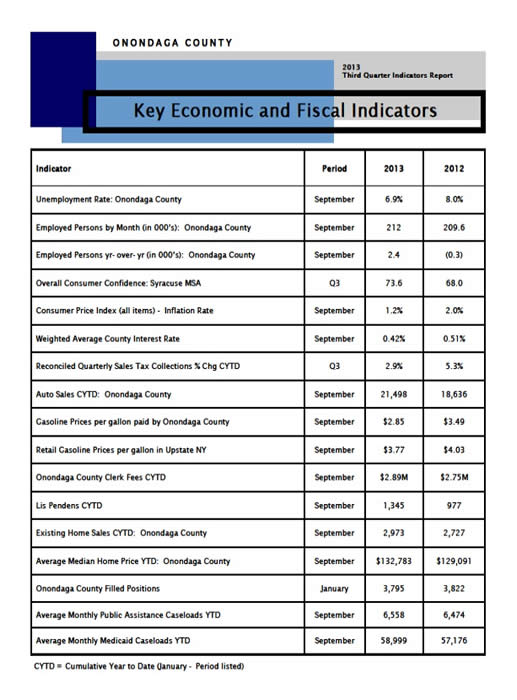
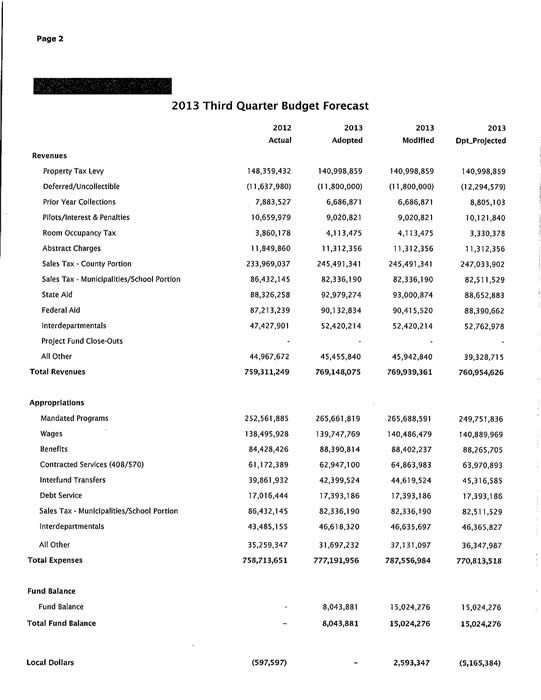
Fund Balance Analysis |
|
|
|
|
|
|
Actual |
2012 Revenue |
$ 759,311,249 |
Less: Sales Tax Pass Through |
(86,432,145) |
Total Revenue for Fund Balance Calculation |
$ 672,879,104 |
|
|
Current Fund Balance Goal 10% |
$ 67,287,910 |
|
|
Unreserved Fund Balance Estimated 12/31/11 |
$ 99,194,072 |
|
|
Appropriated in 2012 |
|
Adopted Budget |
(4,668,684) |
Fund Balance Resolution |
(5,766,441) |
Additional Fund Balance in 2012 |
(7,562,983) |
2012 Surplus/Deficit |
18,595,706 |
|
|
Unreserved Fund Balance - 12/31/12 |
$ 99,791,670 |
Less: Encumbrances |
(3,301,125) |
Prepaid Expenses |
(7,434,194) |
Fund Balance Appropriated in the 2013 Adopted Budget |
(8,043,881) |
Fund Balance Appropriated in the 2013 Modified Budget |
(11,980,395) |
Total Fund Balance Appropriated in 2013 |
(20,024,276) |
|
|
Undesignated Fund Balance - Estimated |
$ 69,032,075 |
|
|
Amount of Fund Balance as a % |
10.26% |
|
|
Amount of Fund Balance over 10% Goal |
$ 1,744,165 |
-
Page 1: used to anticipate where the economy is heading and how this might impact our revenue and expenditures; number of indicators heading in the right direction; Upstate economy struggling to recover – only 50% of the jobs lost have been regained; still cause for caution - lag behind the rest of the country in recovery
-
Page 2: projecting $5.2M surplus; projecting to use $5.2M less than budgeted from fund balance for 2013; sales tax revenue projected to be $1.5M above budget, actual budget 3.43% percent – so far seeing 2.93% over last year; due to strong performance in 2012 projecting to exceed sales tax revenue –ended 2012 with over 5% increase in sales tax over the previous year; strong prior year collection on interest and penalties resulting in $3M projected surplus – due in large part to the city’s aggressiveness on foreclosures of tax delinquent properties; seeing stabilization on appropriation mandates – DSS programs and Special Children’s Services alone are a projected $6M to the good, DSS caseloads 2% less than beginning of 2013; negative side – Corrections federal inmate revenues struggling, projecting a $1.5M deficit; 70 inmates budgeted for in 2013 – not even close, reduced to 35 for 2014; other negative is the Sheriff’s budget with shortages in overtime and Correctional Health
-
Things are headed in the right direction with caution for a shaky economy
Chairman McMahon asked what the number was on the Sheriff’s piercing of the budget, for the tenth year. Mr. Morgan responded the local dollars are about $1.7M.
In answer to Mr. May, Mr. Morgan responded:
- $1.7M deficit includes all account appropriations and revenues for both custody and police
- Includes $850k deficit for civil overtime, $300k deficit for custody overtime and $900k for Correction Health
- Correctional Health number is an estimate; brought in new vendor, may need to add a little more
Mr. Jordan stated that there is about a $2 million deficit total. Mr. Morgan agreed. Chairman McMahon added that if the Sheriff lived within his budget, we would be looking at a $7 million dollar surplus.
Chairman McMahon stated the room occupancy tax number is concerning. Mr. Morgan responded that ROT revenue that used to support the Facilities budget is now being transferred to the Oncenter revenue fund; Facilities is charging the Oncenter revenue fund via an interdepartmental charge for its support. This revenue has been transferred to the Oncenter revenue fund, and budgeted as such in 2014; doesn’t show up here, as it is general fund.
Chairman McMahon stated that in 2013 we saw an historic increase in ROT and asked if the numbers were panning out. Mr. Morgan stated they were. Chairman McMahon stated there is a surplus in the budgetary numbers for 2013, assuming things remain flat, questioned if the numbers are achievable. Mr. Morgan responded that he believes they are.
In answer to Mrs. Ervin, Mr. Morgan continued:
- Page 3: Fund balance number will be impacted by yearend figures; don’t factor in projected surplus until closing of the books
- Undesignated fund balance $69M, $1.7M over legislature’s goal of 10% = 10.26%
Mrs. Ervin stated this was a lot of money and the projection is that it will be even greater. Mr. Morgan responded that if we end the year as projected, it will add to the fund balance. In addition, he noted that the legislature had approved $5 million in fund balance to be used for debt. This number is appropriated fund balance, not spent fund balance. Mr. Jordan stated we are really about $7M over our goal, but $5M has already been committed for debt in 2014. Mr. Morgan agreed. Mr. Kilmartin stated this figure does not incorporate the projection for a $5.1M surplus at the end of 2013. Mr. Morgan stated this was correct.
Mr. Kilmartin asked if there were any other huge demands for fund balance draws coming prior to year end or the beginning of 2014. Mr. Morgan:
-
Correctional Health still something to keep our eye on, could easily see a bigger request
-
Have taken on all the off sites as we transition to a new provider; 1st of the year will be all in and protected with a managed approach; during transition expenses and liabilities must be covered
-
Will evaluate further before the books close and book a reasonable number
Mr. May asked when the new vendor would pick up the off sites. Mr. Morgan responded that the new contract starts January 1, 2014. Mr. May added that we could get lucky and not have serious claims or we could get hit with large numbers. Mr. Morgan agreed.
Mrs. Ervin stated a rainy-day fund is fine, but this looks like a hurricane fund and questioned if we really need to sit on this much money. Chair Knapp responded we will wait and see how the year ends up. We are certainly going in the right direction. Mrs. Ervin added that doesn’t make since to be sitting on this much taxpayer money. Chair Knapp agreed. Mr. Morgan stated that the numbers will be reworked once we have 2013 actual numbers. Currently we are using 2012 actual; may change a little up or down. This number has been more in the past; up to 12 and 13%. Mrs. Ervin noted that she didn’t like the balance numbers then, either. Mr. May added that we have trimmed this over the last few years.
Mr. May asked for a ballpark figure on the debt service increase; realizes the number has been discussed but he doesn’t have it before him. Mr. Morgan responded that it is multimillions. Mr. May stated it is a straight up increase. Mr. Morgan agreed, adding that we saw the increase this year and will see considerably more in 2014 to 2016. We have talked about this at length. Mr. Millea has talked about this in terms of the DOT and WEP, and what we can afford going forward, as we try to keep the balance between cash and debt and the work that needs to be completed. The numbers have been factored into the 2014 budget and we are prepared to deal with those increases. As 2015-2017 come along, there will be additional increases that we face and have to fund.
In answer to Chairman Knapp, Mr. Millea stated most of the increases we are looking at will peak out in 2018-2019, depending on how we deal with the debt issue. This is why we are being conservative going forward. Mr. Fisher:
- 6 year CIP book contains debt schedules
- Departments have to compete for funds available in the debt service that the County Executive is willing to commit
Mr. May stated he questioned how the $7M fits in the future. He would love to understand this better; at least 75% of this is structural savings opportunities; are they windfalls, did we put off things, these are things that are critical. This translates to 5% of the local dollars collected. Mr. Morgan:
-
Positives in the current forecast are partly revenues, will depend on how the economy continues to grow; also some mandate areas
-
2014 projections based on what we saw throughout 2013; economy drives programs to some extent
-
Medicaid went to hard cap and budgeted as such; will be less room for potential savings in these areas as we continue to use information at our disposal for a more precise budget
-
Working on a model to put CIP into the overall County budget; incorporating other pressures we are seeing; can’t look at debt in a vacuum, needs to be looked at across all revenues and expenses
Chairman McMahon asked what the 4th quarter sales tax projection was. Mr. Morgan responded that they projected growth for the year a 2.9; have not completed the 4th quarter as of this point. We just received a payment recently and are at 3.3 over last year. Mr. Kilmartin stated the 4th quarter is typically the strongest quarter. Mr. Morgan responded that this was typical, but as seen in the news people are not shopping as much as they have in the past.
Chair Knapp asked if departments, other than the Sheriff, are in trouble with their budget. Mr. Morgan responded that we will be able to fix appropriations within their own budget. Resolutions will come over in January to tidy up the accounts, there is nothing major.
Chairman McMahon asked how Van Duyn ended up. Mr. Morgan responded that we are still spending money. He is projecting a deficit, but there is a fund balance to absorb this.
Mr. Jordan asked if there were departments that they anticipate coming in under budget for year end. Mr. Morgan responded yes; Special Children’s Services and DSS programs are the two main driving factors for the surplus. Most other departments are pretty much at budget; some variances to the positive and negative but not on a grand scale.
Mr. Jordan asked to be provided with a brief summary on where each department’s budget ends up at year end.
6. ECONOMIC DEVELOPMENT:
a. Amending the 2013 County Budget to Release Contingency Funds for the Farmland Preservation Program ($672,000)
Mr. Knapp stated these funds needed to be rolled over into the 2014 budget to preserve them.
A motion was made by Ms. Williams, seconded by Mrs. Ervin to approve this resolution. Passed unanimously; MOTION CARRIED.
7. WAYS AND MEANS MISCELLANEOUS:
a. Appointment to Board of Directors of the Onondaga County Civic Development Corporation (Mr. Leonard D. Manfrates)
A motion was made by Mr. Holmquist, seconded by Mr. May to approve this resolution. Passed unanimously; MOTION CARRIED.
Chair Knapp called for a recess at 9:45 a.m.; reconvened at 10:03 a.m.
1. WATER ENVIRONMENT PROTECTION: Tom Rhoads, Commissioner; Robert Kukenberger, Vice President CDM Smith
a. A Resolution Approving the Costs of Certain Improvements for CSO Improvements for the Onondaga County Sanitary District
Following introductions, Mr. Rhoads stated Mr. Kukenberger would go through the handout, but he would like to help the committee understand the three main points:
-
Slide 3: Change from $94M Clinton RTF project - better and less expensive alternative
-
Slide 13: Shows why we are here; allocated budget of $61.5M with a $79M project estimate; June 2011 informed Environmental Protection Committee of projected estimate; proceeded with project without increasing allocated budget; project coming in below estimate at $77.7M
-
Project has gone on for many years-prior to him coming to WEP; entire team assembled here for review
- Believe many of the questions will be answered with the presentation
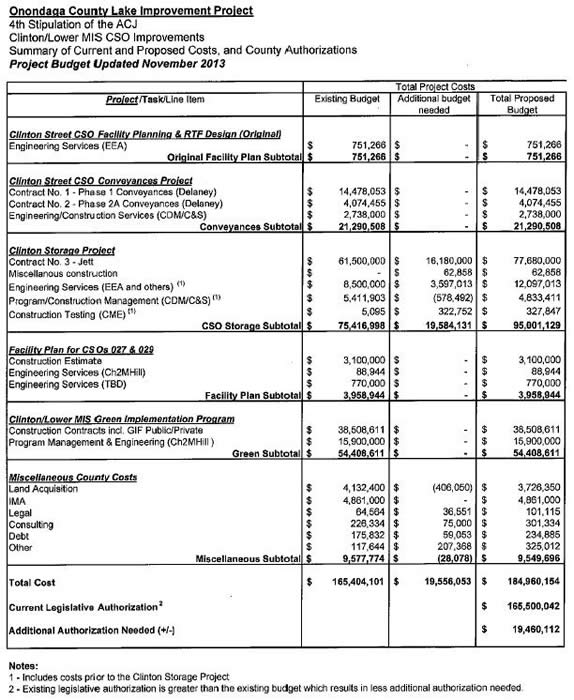
Mr. Kukenberger presented the following:
 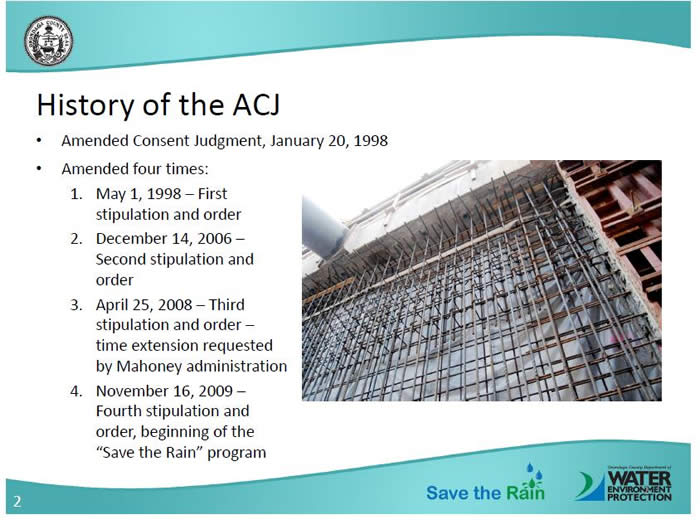
-
Center of picture shows the trolley lot under construction and how close it is to everything around it; high-rise apartment bldg., MOST and Armory Square
-
How this was built and how it operates is very important to the communit
- 2008 County Executive Mahoney asked for timeout to see if there was a better way than the RTFs in our neighborhoods; large conveyance pipelines came along with RTFs very deep and difficult construction
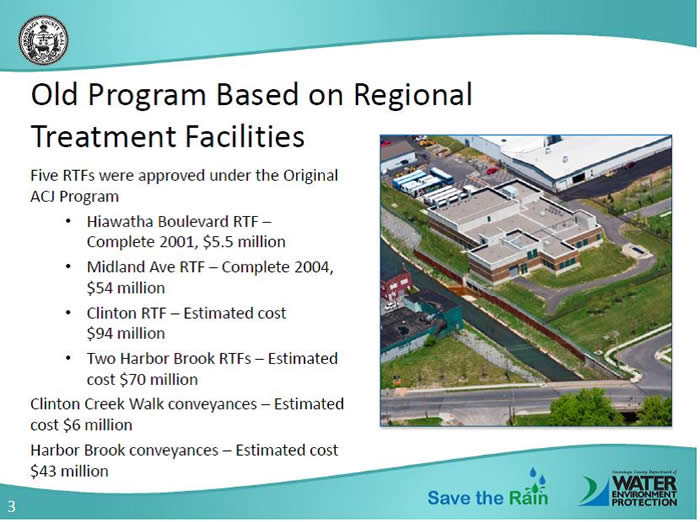 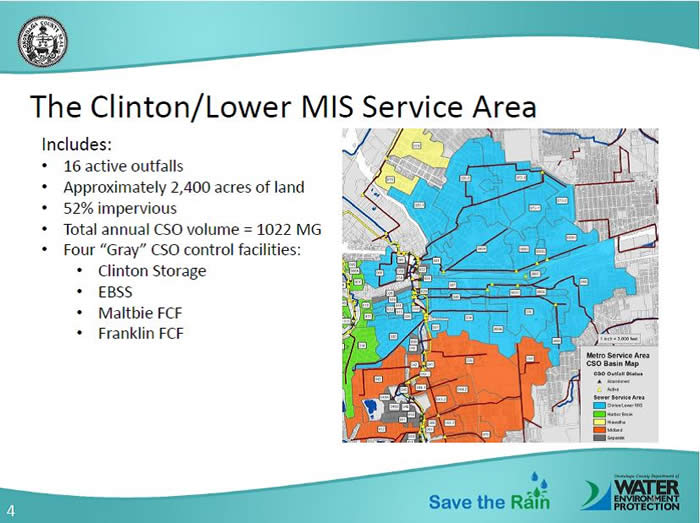
- Need to add $6M to the estimated $94M cost for the Clinton RTF program for conveyance that would have gone under the creek walk = $100M
- 3 separate budgets for Midland, Harbor Brook and Clinton
 
- Swirl technology was used in the RTFs proposed at Clinton and Harbor Brook; inefficient treatment technique
 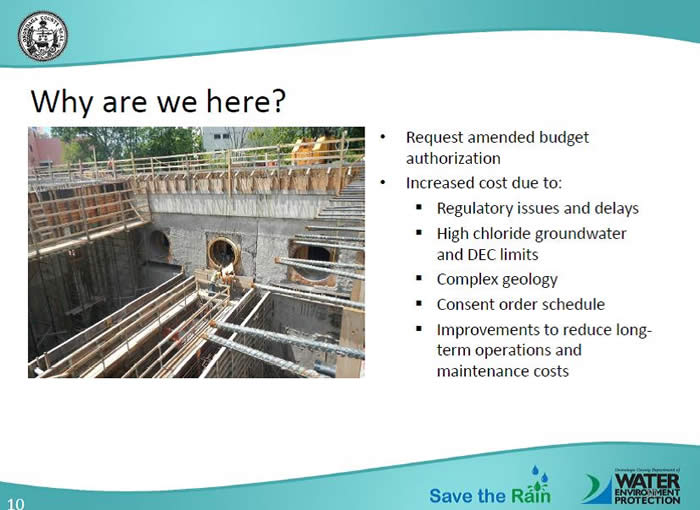
-
Photo shows open cut construction, 850 ft. long, 50 ft. deep and wide; pipes across the top are temporary supports, all were removed at the end of construction

- Bid tabulation presented (On file with the Clerk); range up to $98.8M
- Number of reasons to award low bid; creditable contractor had good plan, alternate methods, and could complete on time; other options of rebidding and/or redesigning looked to be as much, if not more money and project would be delayed
Mr. Rhoads passed out portions of the June 15, 2011 Environmental Protection Committee minutes, obtained from the County’s website (On file with the Clerk) and added the following:
- Great deal of discussion; $61.5M budget, why proceed with a project coming in over budget at $79M
- Number of pressures - ACJ deadlines and $31M in grants
- Here as a matter of reconciliation; former members of the legislature felt it made since to come back when the project was near completion
- In addition to bid increase, want to explain changes during construction; every dollar spent and why it was appropriate
 
-
Borings had shown tunneling area to be mostly clay; hit boulders and had to revise planned technique; first bullet is related to last bullet as construction could not continue for the rest of the project until the pipe was installed; contractor claimed 120 day delay, agreed to 90 delay; time extension estimate of $2.7M and didn’t include other ancillary costs, and fines and penalty cost for missing deadline; acceleration estimated at $2.9M; had detailed discussions and choose acceleration as costs were similar and would be able to meet ACJ deadline
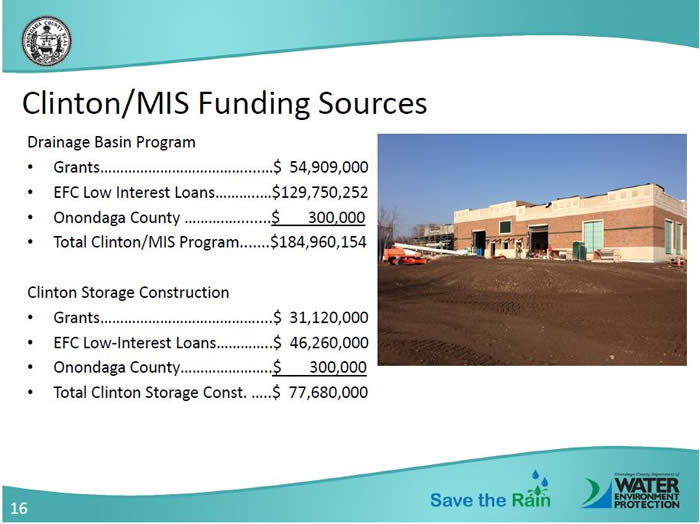 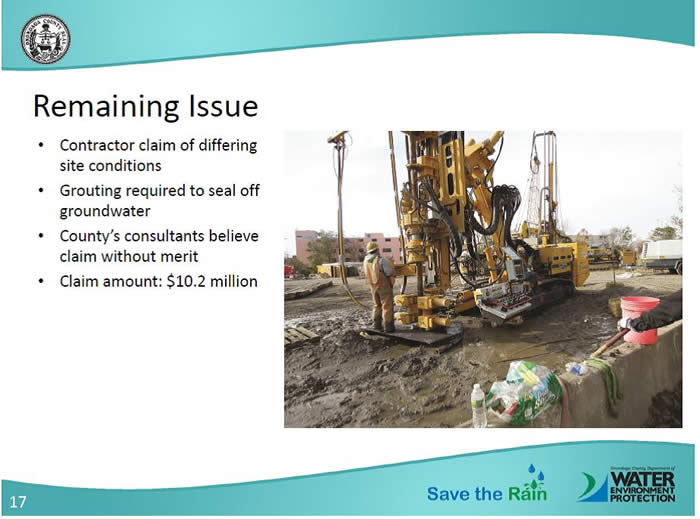
-
$300k estimated number for items not covered via loans
-
Portion is income from trolley lot
- Due to high chloride groundwater created a plug 85-90 ft. below, 5-10 ft. thick; bathtub approach – keeps groundwater from entering the site during construction
- Contractor claiming they ran into site conditions not shown in the contract; caused overtime
- Claim amount not part of requested funds
3Mr. Jordan left the meeting.
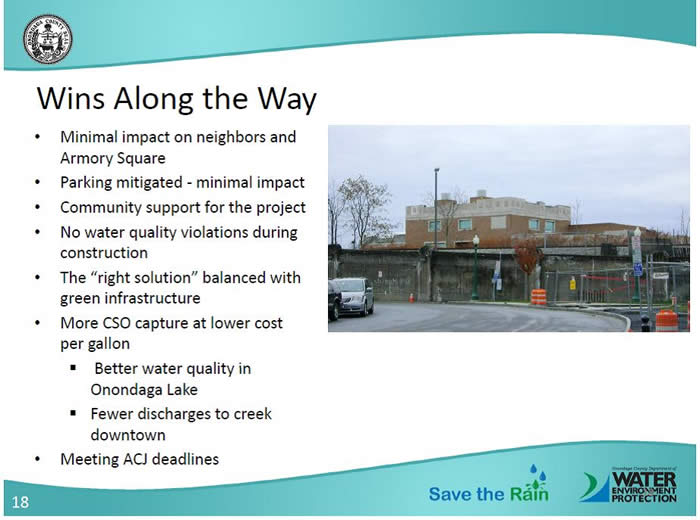 
- Confident right decisions were made; all team members considered and discussed options through planning, design and construction
- Distributed list of Clinton CSO Storage Facility Contractors (On file with the Clerk)
- Distributed EEO Workforce Utilization (On file with the Clerk)
Mr. Holmquist referenced slide 13, there is an allocated budget of $61.5 million, an estimated final of $77.7 million, but are asking for $20 million; questioned where the additional 4 million comes from. Mr. Rhoads responded by referencing the Onondaga County Lake Improvement Project handout; primary driving factor is the engineering services for the Clinton Storage Project - $3.6 million and construction testing.
Mr. Holmquist stated the $20 million figure has to be an estimate and asked if there would be any future surprises. Mr. Rhoads responded that the estimate includes everything, along with a small contingency, so we don’t have to come back; absent the lawsuit claim. Mr. Kukenberger agreed, adding that they anticipate coming slightly under the $77.8 million.
Mr. Holmquist asked if there was dialogue in the June 2011 minutes, pertaining to the $79 million dollar estimate on a $61.5 million budget. If there was clarity at the meeting, it would seem that there would be dialogue about this. Mr. Millea responded that this matter was spoken to at different times in different meetings. We had a 2011 discussion for a $120 million dollar budget that the legislature approved at that time.
Chair Knapp noted that he and seven other members of the legislature were not here in the summer of 2011; nearly half of the legislature never saw any of this. Mr. Holmquist added that in addition, some have never served on the Environmental Protection Committee.
Mr. Millea:
-
October 2010 he had only been with the county for a few months; worked with Mr. Kukenberger and then Commissioner Pastella to create a budget to get through 2018
-
4-5 month discussion to reach approval of the $120M budget; often discussed single caveat of the budget was large capital projects - Lower Harbor Brook and Clinton Storage
-
$61.5M budget based on engineers estimate of designs at that time; found estimates to be off when bids were returned; time compression and complexity of the tunneling design drove the costs upwards to $90M
-
Project is not the project designed in 2010 and 2011
-
Facility had to be built; would come back to true up the final costs
-
Discussion at the June 2011 Environmental Protection Committee was predicated on the unknown; didn’t know what the bids would come back as
-
As seen with Midland, projects with subsurface conditions often have change orders and are open ended
-
Limited request, although $20 million, the rest of the boxes are empty on the project sheet for a reason; not coming back to ask for programmatic funding for other components of the Save the Rain program- strictly for the Clinton Storage project
Mr. Holmquist asked for reassurance that this will pay for everything, except the claim and there will be no more asks.
In answer to Chair McMahon, Mr. Rhoads responded that we are being sued by Jett Industries and have submitted a rejection response; currently in the courts. They are suing on behalf of Jett but have a subcontractor, Hayward Baker, which is part of that claim.
Chairman McMahon asked how we grade ourselves with regard to meeting the goals of the ACJ with this particular piece of the puzzle and know that we won’t need more money. If the lake and creek aren’t clean enough and we don’t meet our goals, you could come back asking for more; explain why this is the fix. Mr. Rhoads:
- Paragraph 14L of the ACJ requires us to complete this project by December 31, 2013 and must be a certain size with a certain amount of capture.
-
This project and the Lower Harbor Brook project are major-milestone projects
-
Information must be submited to the DEC about construction and the ability to accept wet-weather flow as of yearend; preparing to do this -were onsite until 2:30 a.m. witnessing some of the startups
-
Also have other measures, a 95% capture of CSO by 2018 and water quality goals; capture measured by SWMM modeling and water quality measured by ambient monitoring program
Chairman McMahon questioned what happens if this isn’t approved on Tuesday. Mr. Millea responded that we would be extremely constrained in the other components of the program. Chairman McMahon asked if the contractors would stop working. Mr. Millea responded that the project will be finished.
Chair McMahon asked to be provided with dollar figures for the EEO Workforce Utilization.
Chair McMahon asked to be provided with who, what and why detail for legal, consulting, debt and other miscellaneous county costs as listed on the Onondaga County Lake Improvement Project sheet. Mr. Kukenberger agreed to supply the information.
Chairman McMahon stated he agrees that many of us weren’t here. The direction had to change as the County Executive made an ambitious decision to change course, which has proven to be the right decision. We just need all the facts, when we are being asked to approve this cost overrun. Mr. Rhoads noted that historically they provide updates to the Environmental Protection Committee and full legislature. The most recent update is also available online. We have been attempting to keep you informed. The other ancillary costs such as debt are typically fund in a major project when you seek a bond; things such as property appraisals and newspaper publications are in the other catchall line. Chairman McMahon responded that the complete breakdown would be very helpful.
Chairman McMahon stated that he agreed 100% with the way the engineering organizations in this community worked together to keep this work local. At the same time, we want to get a real since of what the impact is and to make sure that if we are appropriating an additional $20 million dollars, the impact is felt here at home.
In answer to Mr. Kilmartin, Mr. Rhoads stated the $79 million figure, listed on slide 13, was a factsheet presented to the EP committee on what the estimated cost would be. Mr. Kukenberger provided background on the timing:
Mr. Kilmartin asked where the numbers listed on slide 13, fall into the Onondaga County Lake Improvement Project sheet. Mr. Rhoads responded that they would all fall into the Clinton Storage Project – Contract No. 3 –Jett. Mr. Kukenberger stated the existing budget column is what was approved when the overall $120 million dollar budget was approved for all of the projects – Clinton, Harbor Brook and Midland.
Mr. Kilmartin asked what percentages of contingencies we typically factored into design estimates. Mr. Kukenberger responded that he believes the contingency amount was 10% after design. We have backup sheets to show the estimates and contingency. Contingency percentage at the end of design is typically 5-10%; even the EPA allows 5% after bid.
Mr. Kilmartin asked for clarification on footnote number 2 at the bottom of the Onondaga County Lake Improvement Project sheet. Mr. Rhoads responded that the current legislative authorization is $165,500,042. Mr. Kilmartin stated this was a bond resolution. Mr. Rhoads agreed, adding the budget itself is $165,404,101. Mr. Kilmartin stated he was referring to the existing budget, not the revised. Mr. Rhoads agreed.
Mr. Holmquist asked if it was a legislative decision to wait for reconciliation of this budget or if it was a shared decision. Mr. Rhoads responded that he wasn’t here; project was awarded over budget and was estimated to be over budget. Mr. Millea stated the discussion for the $120 million budget started in January of 2010. There were discussions and Legislator Corbett was briefed. There weren’t broad discussion with the full legislature, but worked through the committee structure to frame the program, the project progress and the budget cost throughout the duration.
In answer to Mr. Holmquist, Mr. Millea stated that he didn’t want to speak for Mr. Corbett, but believes he would confirm that there was knowledge that this was a complex issue, costs were not as approved in 2011 and having just approved $120 million in early 2011, it wasn’t necessary to come back in late 2011 to approve more money. It was likely that we would see changes, so we waited before coming back in for the request.
Mr. Holmquist stated the good news is that in the end we came in under budget of the increased estimate. Mr. Millea added that we are still far better off than we would have been with the RTFs and the dollars being spent out of this budget are providing tremendous community benefits that otherwise would not have occurred.
Mr. Holmquist noted that not everyone has the benefit of a two hour explanation; none of these answers fit on a bumper sticker. When everyone asks where the $20 million dollars is, he was hoping for some talking points. Mr. Rhoads responded that there has been a high degree of transparency via the minutes and our website postings, including this presentation. People can be directed to where information and answers to their questions can be found. If there are follow-up questions, we are good about responding to the community. Mr. Kukenberger added that the engineering organizations take this seriously, as it is our community as well. We don’t answer to rate payers, but we have to answer to our neighbors and friends.
In answer to Mr. Kilmartin, Mr. Millea stated we are still looking at $15M less in capital costs than the previous program; taking into account the macro program of four RTFs, verses what we have today with two storage facilities, Harbor Brook interceptor sewer, sewer separation projects, and the green infrastructure program. Mr. Kilmartin stated this figure is comparing an actual figure to an estimate for the RTFs, which didn’t go through the site conditions, etc. Mr. Kukenberger stated the $94 million was not a bid price, it is our estimate now and is probably a pretty good number as to where it would have ended up.
Mr. Millea stated that you run into issues with the conveyances, rather than just the facility itself. Mr. May stated the $6 million dollar conveyance demand changed as a result of this direction. Mr. Kukenberger responded that there was a conveyance pipe that would have gone from the back of the MOST and under the creek walk, but was abandon under this program. It was replaced with green infrastructure and sewer separation.
Mr. May stated there was mention made of operating costs. Mr. Millea responded that lifecycle cost will be cheaper with this project. Mr. May added that lifecycle and operating costs would be less. Mr. Rhoads:
- Water quality benefits significantly better; will help meet ACJ compliance
- Reduced O&M costs; gravity bringing water in, smaller pumps and much less energy utilized for dewaterin
Mr. Millea:
- Sanitary sewer system is being impacted by stormwater
-
This facility will retain up to 6M gallons during a storm, then pump to Metro for high level treatment
-
RTFs proposed would have used swirl technology and then dumped into the creek; very likely to have brought additional challenges with water quality; EPA may have said it wasn’t enough and we would have spent millions on 4 RTFs
In answer to Chair Knapp, Mr. Kukenberger confirmed that Hartford is abandoning its swirl technology as it has proven to be ineffective. A $25 million dollar project is being replaced. The Midland facility works as it has storage in front of the swirls; combination of storage, swirl concentrators and disinfectant. There was no room for storage and swirls at the other three locations as proposed.
Chair Knapp asked what the fine structure was, if we didn’t meet the December 31, 2013 deadline. Mr. Rhoads:
- More than DEC fines
-
Attorney General won a judgment for the people of NY – day 1-10 $500 per day, day 11-30 $1,500 per day and $5,000 per day for every day beyond 30 days
- 118 days of delay would have added up quickly
- Also reputation risk, wouldn’t have accomplish our agreed upon goals
- Momentum loss for this project and other
Mrs. Ervin stated that we are ready to bring the project in, on time, with the additional $20 million and asked if long term savings would mitigate these additional funds. Mr. Rhoads:
- Hasn’t compared the savings long-term
- Resolution contains a breakdown of the $20M; results in a $5 per household fee for 30 years
- Savings of roughly $260k O&M cost over 180k units – about $1 per household each year; life of project 75 years or more, should pay for itsel
Mr. May stated the massive encumbrance of debt warrants revisiting the rate structure. When we talk about households, we are talking about inequities, as discussed in the past. Mr. Millea responded that both he and Mr. Rhoads look forward to working with the legislature on this. There are different ways to charge for the service.
A motion was made by Mr. Kilmartin, seconded by Ms. Williams to approve this resolution. Passed unanimously; MOTION CARRIED.
b. A Resolution Authorizing the Issuance of $20,000,000 Bonds of the County of Onondaga, New York, to Pay the Cost of CSO Improvements in and for the Onondaga County Sanitary District, Intended to Enable the County to Comply with Requirements Set Forth in the Amended Consent Judgment and Related Municipal Compliance Plan for the Clinton Street Conveyances and Regional Treatment Facility Project, in and for Said County ($20,000,000)
A motion was made by Mr. Kilmartin, seconded by Ms. Williams to approve this resolution. Passed unanimously; MOTION CARRIED.
c. Reducing Authorized Costs for Certain Improvements Made for the Midland Wastewater Treatment Plant in and for the County of Onondaga, New York pursuant to Section 41.00 of the Local Finance Law, and Amending the Resolution Nos. 50-2008 and 51-2008
.
In answer to Mr. Kilmartin, Mr. Rhoads responded:
- Reduction of $9,756,000 in Midland project, plus additional $20M for Clinton = $10M
- Net effect would be $2.50 increase to the rate payer
- Separate resolutions as they are separate sewer shed
Chair Knapp asked what went well with the Midland project. Mr. Rhoads responded:
- Save the Rain approach; considerable conveyances would have feed into the RTF
- Change in approach avoided some capital expenditures and disruption to neighborhoods
- Flow captured in groundwater; doesn’t have to go back to Metro
A motion was made by Mrs. Ervin, seconded by Mr. May to approve this resolution. Passed unanimously; MOTION CARRIED.
8. LAW:
a. Litigation Update
A motion was made by Mr. Holmquist to leave regular session and enter executive session for the purpose of discussion of pending litigation regarding the matters of JACQUELINE A. MOGLE vs. GARY M. DIXON, ONONDAGA COUNTY PARKS and COUNTY OF ONONDAGA; and THERESA CISZEWSKI vs. NICHOLAS J. FICK and COUNTY OF ONONDAGA; and DONNA T. SHIRTZ vs. COUNTY OF ONONDAGA and WILLIE B. JONES; seconded by Mrs. Williams. Passed unanimously; MOTION CARRIED.
A motion was made by Mr. Kilmartin, to exit executive session and enter regular session, seconded by Mrs. Ervin.
Chairman Knapp noted for the record that no action was taken during executive session.
A resolution was distributed, entitled, Authorizing the Settlement of the Action Filed with the Supreme Court of the State of New York, County of Onondaga, Jacqueline A. Mogle vs. Gary M. Dixon and County of Onondaga.
A motion was made by Mr. Kilmartin, seconded by Mrs. Ervin to approve this resolution. Passed unanimously; MOTION CARRIED.
A motion was made by Mr. Kilmartin, seconded by Ms. Williams to way the rules and allow the Theresa Ciszweski case to move forward to general session. Ayes: 5 (Kilmartin, Holmquist, Ervin, Williams, Knapp); Noes: 1 (May). MOTION CARRIED.
The meeting was adjourned at 12:01 PM.
Respectfully submitted,
KATHERINE M. FRENCH, Deputy Clerk
Onondaga County Legislature
* * *
|












